Weird War II by Fossilized Rappy
Introduction
Original SA postTatum Girlparts posted:
Also, AEG had a ton of books that were basically {ONE WORD CONCEPT} and if I'm remembering rightly they all sucked terribly.
Speaking of Dungeons and Dragons 3E material, though, let's talk about...

Introduction
From the same people who brought you Deadlands d20 came Weird War II. Coming out of that turn of the millennium d20 system boom, Weird War II was another product like Broncosaurus Rex that made the effort to push the Dungeons and Dragons 3.0 rules into a more modern setting before Wizards of the Coast even started thinking about d20 Modern. Thankfully, we won't have any Confederate heroes and Union villains this time, just good old-fashioned Nazi punching.
Of course, if you couldn't guess from the name Weird War II, this is the big war with a twist. Those Nazi occultists you heard about? They have real magic, forged out of either blood rites or Germanic runes. They also have undead soldiers, mad science-produced abominations, automatons, and apes with human brains. Furthermore, the Japanese have oni marching alongside their soldiers, the Allies have spirits of battle aiding them against the occult powers of the Axis, haunted vehicles are trundling around the battlefields, and things from old mythology are stirring and none too happy about all of the stupid humans waging their country wars without respect for the peace of the old beings. It's a paranormal mess, and you play a military member or resistance fighter caught smack-dab in the middle of it.
I'm going to be covering all of the books from the D&D 3.0 era of Weird War II, but don't expect any really set order to stick. I'll be obviously doing the core book, Blood on the Rhine, first, but after that it's a crapshoot. I'd say that second will probably be the bestiary Horrors of Weird War II and then the third will be the Russian sourcebook Hell Freezes Over, but after that I'll probably just move on a whim.
In the dark past of 1944, there is only WAR
Original SA post
Part 1: In the dark past of 1944, there is only WAR
Chapter 1
The very first chapter of the core rulebook Weird War II: Blood on the Rhine isn't really weird, but it certainly is very war. Two World Wars, in fact, as it goes over the real world history of World War I, its effects on Germany, and World War II. Obviously you either know this from history class or could just Wikipedia it up, and there's only one "What If?" sidebar in this chapter discussing the possibility of an alternate universe where the Battle of Britain was lost and Germany managed to steamroll the seas during Operation Sea Lion, so we'll head to the next chapter.
Chapter 2
Chapter 2: Characters begins with a short overview of just who you are playing. Big surprise, you are playing humans in World War II.
World War II: Blood on the Rhine posted:
Let’s start with which side you’re on - the Allies. The Axis are the bad guys. The view of this game and its authors is that Hitler and the Nazis were evil. Individual soldiers (outside of the SS) and civilians are somewhat compelled to follow them. See the sidebar on page 45 for a longer discussion on this game’s take on Germans and Nazis.
The Allies are the heroes of this war. There are certainly examples of Allied war criminals and atrocities, and in the annals of the Weird Wars,there are certainly some American, English, Polish, and Russian villains to be encountered and defeated by stalwart heroes.
This doesn’t mean a War Master can’t run a German campaign. The classes included here work for any nationality. Just beware. Being the pawns of pure evil isn’t a lot of fun. We leave this part of the game to you and your game group’s collective conscience.
"We're not saying you can't run a Nazi campaign, man, just it's not blood on our hands."
So, since everybody's human, that pretty much leaves character class as the big defining difference between party members. There are a grand total of five base classes presented in the core rules for Weird War II, as follows:
-
Grunt:
Congratulations, you're a Fighter with a gun. You get bonus feats, full Base Attack Bonus progression, and...that's pretty much it. Like I said, you are quite literally a Fighter with a gun.
-
Officer:
Congratulations, you're a Fighter with a gun, slightly different bonus feats to choose,
and
a high Will save rather than high Fortitude save. So exciting.

-
Medic:
While you don't have a full Base Attack Bonus like the Grunt or Officer, you get high rate of progression for both your Fortitude and your Will saves, and you also get class features related to healing at every other level. You also happen to be immune to fear effects, which is certainly helpful in a game with lots of horror-themed monsters.
-
Resistance Fighter:
The Resistance Fighter kind of sucks, to be blunt. High Reflex saves and +1d6 sneak attack damage every six levels, which means that by 20th level you will have a grand +4d6 compared to a 20th level Rogue's +10d6, and with none of the Rogue's trap sense of special abilities either. You also have uncanny dodge and some field contacts that allow you to get hold of a weapon, German uniform for spying, some backup from a local resistance cell, or the location of a safehouse, but you can only use a contact once a week while in your home country.
- Scout: You want to play a Scout? Well then, congrats, you have picked the class slightly less useless than the Resistance Fighter! The Scout gets sneak attack too, but at a rate that ends with slightly more (+5d6), and also gets the uncanny dodge ability. On top of that, he also inherits some of the Ranger's nature-related class features.
After that, there's a section on ranks in the US, UK, and German militaries, some rules on just what POWs can and cannot do based on the rules set down at the Hague in 1907, and statements on how you are pretty much forced into a special division if you want to play a female, black, or Japanese-American character. Thankfully, there's a special organization called the Office for Supernatural Inquiry that is progressive and lets everyone in to fight and learn, which means that the segregated military isn't relevant unless your
The final part of chapter 2 deals with the command structure of the Allies and the Nazis, as well as the French Resistance. It is more historical information you probably know, but is also noteworthy for having an actual photo of desiccated corpses being dumped out of a death camp. I can't say I was expecting that in my D&D game about fighting Nazi zombies.

--------------------------------------------------
Next time: skills, feats, and equipment.
Language
Original SA post
I'm going to add to the vote for
Cradle and Crescent
. Ars Magica seems to have writers that can manage to pull off a sourcebook on Islam without having an off-day White Wolf-style faceplant.
EDIT: Oh hey, it won without my help. Yay for writing a post while events happen.
Speaking of White Wolf, the following post has absolutely nothing to do with them, so this segue is pointless.

Weird War II Core Rules review, Part 2: Language
Chapter 3: Skills and Feats
Being a setting meant to take Dungeons and Dragons 3.0 into the world of the 1930s and 1940s, it shouldn't really be surprising that there are new skill and feat rules that need to be added on. This starts with a list of some changes to classic D&D skills. First off are restrictions - that is, some skills you can't even take cross-class ranks in, they are locked to a specific class and you just have to deal with it. Alchemy, Scry, and Use Magic Item can only be used by characters with the OSI Adept prestige class (prestige classes won't be seen until chapter 6), Knowledge (Arcana) can only be taken by individuals affiliated with the Office for Supernatural Inquiry, and Decipher Script requires either the OSI Adept prestige class or OSI Operative prestige class (because god forbid the Resistance Fighter base class or the like get the ability to decode things). Second are new Knowledge skill subtypes, namely Biology, Chemistry, Engineering, Geology, Mathematics, Meteorology, Military, and Physics. And thirdly, there is the altered Speak Language. Oh my...
If you know your d20 system, Speak Language is usually a simple "take a rank (or two if it's a cross-class skill) to know how to speak a language". Weird War II instead has Speak Language have ranks like other skills. One rank gives you just a smattering of words in the language, two ranks lets you make simplistic sentences, three ranks lets you speak most average sentences, four ranks lets you speak with accented inflections, five ranks lets you speak the basic language flawlessly, and six ranks lets you mime specific regional accents and dialects of the language. You automatically get five ranks in your native language. Even better, if you have less than five ranks in a language, you have to make Speak Language checks to get your speech right. And speaking very slowly lets the guy you're speaking to make a Listen check that gives you a bonus to your Speak Language check if you succeed.
As for completely new skills, they are as follows.
-
Artillery:
Instead of just making an attack roll, you instead make a check with this skill to hit with mortars and indirect fire weapons.
-
Combat Medicine:
It's the Heal skill, only restricted to the Medic base class. Sorry if you thought you could take cross-class skill ranks in this to actually make yourself useful at something as critical as field dressing, Resistance Fighter!
-
Demolitions:
The skill to either set explosives, disarm them, or guess how much of them you happen to need for a situation.
-
Driving:
Self-explanatory.
-
Leadership:
A skill specifically made for the Command feat (we'll get to that in a moment) and its effects.
-
Mechanics:
The Weird War II name for a Repair-style skill.
-
Navigation:
Reading a map or traveling by the stars.
- Prayer: A check with this skill is made any time an OSI Chaplain wants to have a miracle happen. This won't be relevant until we get to the OSI Chaplain and other prestige classes in Chapter 6, so don't sweat trying to figure it out.
You may be wondering where the Pilot skill is to offset the Driving skill - it's World War Ii, after all. Well, you will have to wait for the Weird War II sourcebook Dead From Above for that.

Most of the feats are for proficiency in some sort of transport or weapon - Automatic Weapons Proficiency (submachine guns and automatic rifles), Firearms Proficiency, Flamethrower Proficiency, Gunnery Proficiency (artillery and vehicle-mounted weapons) Gyrostabilizer (you can't read the readouts of a tank's gyrostabilizers without it), Mortar Proficiency, Parachute Proficiency, Rocket Launcher Proficiency, Tracked Vehicle Proficiency, and Wheeled Vehicle Proficiency. What few other feats there are range from wasteful such as Eagle-Eyed (you get a +2 bonus to Listen and Spot checks...but only at 100 yards away or further. Why not just take Alertness for the same bonus at no range limit?) to actually somewhat useful ones such as Command (if you succeed on a Leadership roll, you can grant the soldiers under your command your Initiative modifier -1 rather than their own Initiative modifier, letting them all move together at a rate potentially higher than their foes).
Equipment
We'll be going over equipment rather quickly, as most of the actual rules for new types of weapon combat and vehicles don't appear until next chapter.
-
Pistols:
Statistics are provided for the Browning HP, Colit M1911A1, Engielf N2 Mk1, Liberator M1942, M1917, Luger, civilian revolver, Walther PPK, Walther P38, and Webley Mk4 pistols. All deal 2d6 damage, some of them with a plus or minus of 1 or 2 to damage. Unlike Wizards of the Coast's d20 Modern firearms, which created a new special type of damage called Ballistic, firearms in Weird War II deal Piercing damage.
-
Submachine Guns:
Stats are provided for the M1 Thompson, M3 Greasegun, MP35, MP40, and Sten. All do 2d6 damage, with the M1 Thompson and M3 Greasegun having a +2 bonus to their damage rolls.
-
Shotguns:
The shotguns given are more generic than the other weapons: the single barrel, double barrel, sawed-off single barrel, and sawed-off double barrel. In spite of being simplistic in their names, they are so
 in rules and variable damage dice that we will just wait until the combat chapter to get into that quagmire.
in rules and variable damage dice that we will just wait until the combat chapter to get into that quagmire.
-
Rifles:
Stats are given for the De Lisle carbine, Gewehr 43, KAR-98K, M1, M1 Carbine, M1903A3, M1903A4, N.4 Lee-Enfield, and civilian rifle. The De Lisle carbine deals 2d6+2 damage, while all the others deal 2d8.
-
Machine Guns:
You get the Sturmgewehr 44, BAR, Bren gun, M1919A4, M1919A6, M2, MG34, MG42, and Vickers guns. The Sturmgewehr 44 deals 2d8-1 and the M2 deals 2d10 damage, while the rest deal 2d8.
-
Hand Grenades and Explosives
Lots of things that go boom, with the AN-M9, Bangalore torpedo, stick of dynamite, Geballte Ladung, N.23 MkII, M9A1 rifle grenade, MkII Pineapple grenade, Molotov cocktail, Panzerwurfmin, plastic explosive, small satchel charge, large satchel charge, Schiessbecher AT, Schiessbecher HE, Stielhandgranate 24, Stielhandgranate 24 with spliterringe, smoke bomb, and a charge of TNT. These are probably the most widely varying weapons, ranging from non-damaging smoke with the AN-M8 and smoke bomb and 4d6 with a stick of dynamite to a brutal 10d10 for a large satchel charge.
-
Rocket Launchers:
We get the bazooka, Panzerschreck, Panzerfaust 30, Panzerfaust 60, and PIAT. They range from 5d8 to 7d8 in damage, but the oddest thing is the type of damage they deal: a mixture of piercing and fire. I dunno if I'd really classify rocket launchers as fiery, but whatever.
-
Flamethrowers:
The Flammenwerfer, MkI flamethrower, and Lifebuoy all deal 4d10 fire damage but vary by rane and weight.
-
Melee Weapons:
If you need something more blunt and don't happen to have more archaic weapons, stats are provided for a rifle butt strike, bayonet, entrenching tool, and garrote.
-
Antitank Guns and Antiaircraft Gun
I'm not even going to try to list these, as the table around them becomes a huge clusterfuck.
-
Landmines:
These are the antipersonnel mine, antitank mine, and S-Mine 44. Why they weren't listed back in the section on grenades and explosives is beyond me.
-
Mortars:
The 2-inch mortar, 3-inch mortal, 60mm mortar, 81mm mortar, Granatewerfer 34, and Granatewerfer 36 are provided for those who want to make things blow up. They have a burst radius and deal piercing/fire damage like rocket launchers.
-
Equipment:
For non-weapons, equipment varies from medical kits and survival kits to rations and canteens. They are all equally mundane. Oddly enough, the only three pieces of armor - the flak jacket, steel helmet, and tanker helmet - are placed here, and only have a weight and Armor Class bonus rather than any of the further marks that are usually used for D&D armor.
- Vehicles: Some trucks and tanks from Germany, the UK, and the USA. Wee.
-------------------------------------------------------
Next time: the combat rules and prestige classes chapters, wherein shotgun enthusiasts will probably cry.
Shooting, Saints, and Spies
Original SA post
I do believe I heard a call for supernatural creatures in World War II gear.

Part 3: Shooting, Saints, and Spies
Chapter 5: Combat
Are you ready for a primitive attempt at firearms rules for Dungeons and Dragons 3.0? I hope you are, because that's what you're getting. So, let's start with a quick rundown of new combat rules related to guns.
-
Automatic Fire:
Automatic weapons in Weird War II work by having a bonus from particularly successful attacks. An attack roll that beats the enemy's Armor Class by 5 points gets to roll its damage twice, while one that beats the AC by 10 points gets to roll for damage three times, reflecting multiple bullets from the automatic weapon pelting into the same target.
-
Bracing:
If you fire a machine gun or automatic rifle from the hip or while moving at faster than a slow 5 ft. square walk, you suffer a -4 penalty to your attack roll. An action movie star you aren't.
-
Misfire:
You rolled a 1. Not only do the dice gods hate you, but you get to roll a 1d6 to see whether you shoot someone randomly on a 1, drop your weapon like a dumbass on a 2, or have to take a move action and Dexterity check to clear a gun jam on a 3 to 6.
-
Reloading:
Takes a full round action to reload 1d4 + Dexterity modifier number of bullets into an internal magazine, move action to rip a clip, and then a belt-fed weapon reload is either full round for one person or move action for two.
-
Stray Bullets:
If you fail an attack roll on someone with people within 5 feet of them, you get to roll a d6 for each of those people until you either get a 1 and thus shoot someone or run out of targets to roll for. Again, an action movie star you aren't.
- Suppressive Fire: You can spend 10 bullets to make a full round action of sweeping a designated 20 foot-radius area with your firearm. Anyone in that area who isn't in total cover has to make a DC 15 Will save or lose their action for the round, and they take damage from your gunfire if they manage to be unlucky enough to roll a 1.
Then there are shotguns. Oh, shotguns. They are weapons that look at the normal ranged weapon combat rules and go "I'm making my OWN path!" Rather than suffering penalties to attack rolls based on increasing range increments, shotguns instead do something entirely unique. Namely, for each range increment past the first, they gain a cumulative +2 bonus to attack rolls up to a maximum of +6. At the same time, however, they lose entire damage dice as they travel. You need to shoot a target point blank to get the full 4d6 damage of Weird War II shotguns - a single range increment lowers it to 3d6, two range increments to 2d6, and three to 1d6. Because apparently just having something like exchanging attack roll bonus for damage roll penalty would have been too easy and not enough to screw over everybody's favorite chew toy. That's right, the Resistance Fighter class is stated to be pretty much the only character type that uses shotguns.

The rest of the material is a bit less noteworthy. Flamethrowers are sort of like breath weapons, grenades are sort of like acid splash damage, smoke grants concealment, the concept of
Vehicles are also mentioned, and they are pretty much mindless mounts with a special [s[Hardness[/s] Armor (not to be confused with Armor Class ). You have to make a Driving check any time the vehicle's Armor rating is bypassed by damage, if there's hazardous terrain, or you want to do a fancy stunt driving maneuver.
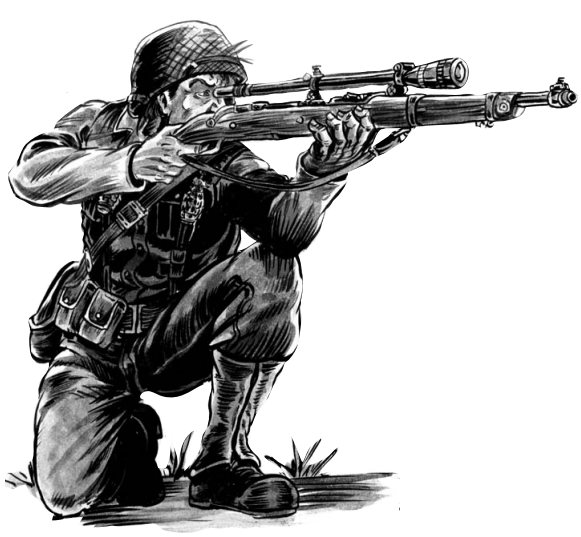
A lot of the imagery in Weird War II is actual photography from World War II. Here's what it looks like when it isn't.
Chapter 6: Prestige Classes
There are five 10-level prestige classes unique to Weird War II's core rulebook, just like there are five base classes. It's a coincidence, but an amusing one to note.
-
Commando:
The prestige class to make a Grunt who is better at being a resistance fighter than the Resistance Fighter. You get full Base Attack Bonus progression, high Fortitude and Will save progression sneak attack up to +4d6, bonus feats at every other even-numbered level, and the feats Endurance and Improved Unarmed Strike for free.
-
Sniper:
As anyone who plays Team Fortress 2 knows, Snipers can be on-shotting assholes. This class is no different. With a full Base Attack Bonus progression and class features that grant a long range coup de grace headshot, a special crippling shot to deal either Dexterity or Strength damage rather than Hit Point loss, and an ability that forces anyone who sees a headshot or crippling shot to make a DC 25 Will save or suffer a -4 morale penalty to
any roll
for 24 hours. You don't fuck with snipers.
-
OSI Agent:
The Allies' equivalent of Nazi rune mages, the OSI Agent prestige class has a high Will save progression, the ability to create magic runes, and...that's it, really. Runes will be actually covered when we hit the chapter on magic.
-
OSI Chaplain:
Like the OSI Agent, the OSI Chaplain is a one trick pony. That trick is being able to make use of the Chaplain-unique Prayer skill. Make a Prayer check and succeed, Jesus or whoever you happen to worship is in a good mood and he lets you do miracles (it's divine magic, right up to
spellsmiracles per day). A Chaplain can also turn undead. If the chaplain commits a sin, they lose their ability to call on miracles for 1d6 hours if it's a little sin, 2d6 days if it's a big sin, or until an atonement quest for murder or another top-tier sin. The game doesn't actually really explain what sins count for what rank in any religion other than Christianity, so it's pretty much up to the War Master.
- OSI Operative: The OSI Operative is an assassin, more or less. The class has high Reflex and Will save progression as well as high (but not full) Base Attack Bonus Progression, gets sneak attack bonuses up to +4d6, free full ranks in three different languages chosen from a specific pool of Allied and Axis languages, free Exotic Weapon Proficiency with the garrote, and a literal license to kill civilians and allied soldiers if there's a supernatural threat involved.
-----------------------------------------------
Next time: Magic and haunted vehicles.
The Return of Ghost Tank
Original SA post
Part 4: The Return of Ghost Tank
Chapter 7: Magic
If you somehow couldn't guess from last chapter's prestige classes and the fact that this is an occult war setting, Weird War II does indeed have magic. As with its source material, Weird War II's magic is divided into the arcane and the divine (retooled as miracles and rune magic) - unlike standard D&D 3.0, however, both have a few catches. We'll cover miracles first, as they are covered first in the chapter.
A miracle is the form of divine magic utilized by Chaplains. While the spells are pretty much the same as those cast by a D&D Cleric, they only go up to 5th level total and are cast in a different manner. The Chaplain doesn't need a holy symbol, but instead must make a loud proclamation to his deity over the course of the time it takes to cast the spell, then make a check with the unique Prayer skill at a DC of 15 + twice the spell's level. If the check succeeds, the spell is cast, while a failed check means God's got you on the answering machine line and you're out of luck. Furthermore, successfully invoking a miracle or botching a Prayer roll with a natural 1 fatigues the Chaplain's body, dealing nonlethal damage equal to 3 times the spell's level (1 for a 0-level spell, as they aren't left out).
As for arcane magic, it takes the form of rune magic, based on old Germanic and Norse runes. Both Allied Adepts and Nazi Blood Mages harness the power of runes to fuel their ancient and dangerous form of magic. To cast a spell with run magic, you must have studied and understand the specific runes tied to a specific spell. The casting and fatigue is pretty much on the same rate as miracles, but replacing the Prayer skill with the Spellcraft skill and invoking the meaning and inscription of the rune rather than performing prayer. You can choose to skimp out on either the talking or the rune carving part of the spell, but doing so increases the Spellcraft DC by 10. Runes can be carved straightforward or made into a dark "merkstave" rune to perform darker or opposed facets of the rune. The specific runes are as follows.
-
Fehu:
Fehu, the cow rune, is associated with the goddess Freya, the dwarves, material wealth, and fire. It is a rune of material possessions, bounty, and creation, while its reversed or merkstave form is that of poverty and loss, failure, greed, atrophy, cowardice, and bondage.
-
Uruz:
Uruz, the aurochs rune, is the rune of the earth and the powerful triad of Odin, Thor, and Loki. It is a rune of physicality, being associated with strength, speed, and good health or made merkstave into weakness, impulsiveness, and disease.
-
Thurisaz:
Thurisaz, the giant rune, is a rune of Loki and the giants. Its nature is that of cleansing through fire, purposeful destruction, and strife, while its merkstave is that of helplessness, compulsiveness, and evil thoughts.
-
Ansuz:
Ansuz, the rune of Odin, is unsurprisingly associated with Odin. It brings with it insight, wisdom, visions, and compelling oratory, while its merkstave is that of delusion, confusion, and manipulation.
-
Raidho:
Raidho, the wagon rune, is associated with both Thor and the Norse people as a whole. Its meaning is that of travel and progression of the journey of life, while its merkstave is stagnation and death.
-
Kenaz:
Kenaz, the beacon rune, is tied to Freya, Heimdall, the dwarves, and the fire giants of Muspelheimr. It is a symbol of transformation and light, while its merkstave is the taint of disease and uncontrolled instability from chaos.
-
Gebo:
Gebo, the gift rune, is used as a mark for the folk heroes Sigurd and the valkyrie Brunhild, as well as Odin himself. To invoke gebo is to bring gifts and ties of relationship, while its merkstave manifests greed, solitude, and ties merely of obligation.
-
Wunjo:
Wunjo, the rune of glory, is associated with the divine realm of Asgard and to the gods Baldr and Odin in particular. Its purpose is for joy, fellowship, and peace, while its merkstave brings discord, sorrow, and the rage of the legendary berserkers.
-
Hagalaz:
Hagalaz, the hail rune, is tied to Ragnarok and its instigators, as well as to Hel and her cold realm. It is a rune of weather in its unchanged state, while its merkstave embodies natural disaster, suffering, and the hollowness of loss.
-
Nauthiz:
Nauthiz, the rune of need, is typically associated with Freya and Skuld. Its meaning is of endurance, overcoming conflict or restriction, and survival in general, while its merkstave stands for slavery and base desires such as hunger and the need for shelter.
-
Isa:
Isa, the ice rune, is associated with the frost giants and the kingdom of Niflheimr. It is a rune of challenges and steadfastness, while its merkstave enforces blindness and illusion, deceitfulness and treachery, and stealth.
-
Jera:
Jera, the harvest rune, is tied to Freya, Sif, and Thor. It is the rune of peaceful times, and its merkstave manifests setbacks and ill-timed events.
-
Eihwaz:
Eihwaz, the yew rune, is associated with the world-tree Yggdrasil and both sides of life with Hel and Odin. Protection, reliability, and strength are the marks of this rune, while its merkstave harkens acts of confusion and weakness.
-
Perthro:
Perthro, the dice rune, is associated directly with Freya and Freya alone. Her rune focuses on uncertainties, hidden knowledge, and prophecy, while its merkstave reflects addiction or ignorant stagnation.
-
Algiz:
The rune of protection, Algiz is tied to Heimdall and the ranks of the valkyries. Its symbology is warding of the body and the soul, while its merkstave is unseen danger and removal of magic.
-
Sowilo:
Sowilo, the sun rune, is associated with Baldr and the German goddess Sunna that gives our bright orb its name. It is a rune of vitality and success, while its merkstave is justice and revenge.
-
Teiwaz:
Teiwaz, the rune of Tyr, is associated with its namesake god. Honor and victory in battle is its forte, while the merkstave of the rune reflects failure and missteps in speech.
-
Berkana:
Berkana, the birch rune, is associated with Berchta, Frigg, and Idunna. It is a rune of fertility and growth, and its merkstave is one of lack of control or carelessness.
-
Ehwaz:
Ehwaz, the horse rune, is associated with Freya and the magical horse Sleipnir. It is the rune of change, loyalty, and movement, while its merkstave is one of deception and betrayal.
-
Mannaz:
Mannaz, the rune of humanity, is tied to Midgard. It is a rune of human intelligence and self-awareness, while its merkstave is that of manipulation and loss of senses.
-
Laguz:
Laguz, the water rune, is associated with Njord and Jormundgandr. It is the rune of water, dreams, and the unknown, and its merkstave reflects confusion and madness.
-
Ingwaz:
Ingwaz, the earth rune, is one of the gods Freya, Nerthus, and Thor. It is tied to the home and male fertility, while its merkstave is impotence and pointless nomadry.
-
Dagaz:
Dagaz, the day rune, is tied to Baldr, Heimdall, and Sunna. Its meaning is one of clarity and neutrality, while its merkstave signals the end or completion of something.
- Othala: Othala, the property rune, is associated with all-seeing Odin and the nine worlds that sit upon Yggdrasil. It is a rune of inheritance, order, and prosperity, while its merkstave is of poverty, slavery, and ill will.
So, just what do all these runes actually mean in practice? The 0- through 5th level spells the Adept or Blood Mage attains are the same as a Wizard or Sorcerer, but are tied to specific runes, the number of runes increasing with complexity. For instance, while casting the spell light only requires calling upon the power of Kenaz, casting wall of iron requires the combined runic symbology of Algiz, Othala, and Teiwaz.
Chapter 8: Haunted Vehicles
For some reason, this gets its own chapter rather than being part of the bestiary chapter later on. A haunted vehicle is basically sort of like a class that can be taken by a vehicle that has gained intelligence from a ghost that haunts it. Each level allows the hanted vehicle to pick up a special power that can vary from damage or spell resistance up to becoming invisible or raising the dead. By paying experience points, a player group can have a haunted vehicle (or even a small squad of haunted vehicles if you are willing to pay the hefty price) as a companion NPC for their group.
---------------------------------------------------------
Next time: we get to the thickest chapter in the book, the gamemaster's section! Oh, and there's a small bestiary-before-the-bestiary-book too.
The Rest of the Core Rulebook
Original SA post
Part 5: The Rest of the Core Rulebook
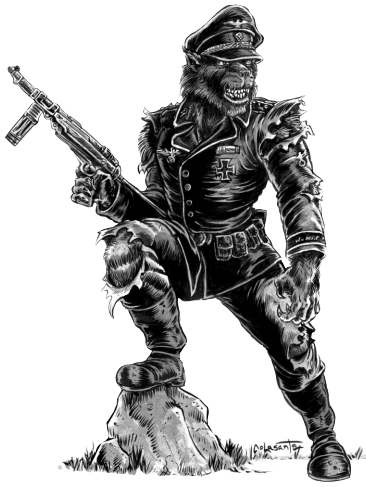
Chapter 9: Officer's Country
AKA the Game Mastering chapter. The majority of this chapter deals with either the Allies or the Germans - just as aircraft aren't really covered until the sourcebook Death From Above, other Axis forces are only really expanded upon in Africa Korpse (the Italians) and Land of the Rising Dead (the Japanese). Still, it does finally give us a look into the weird part of Weird War II, so I can't really fault it too hard.
Up first are the origins of the whole magic conflict. While an evil-hunting secret society known as the Sons of Solomon have been trundling around for a while now, the first big discovery of magic for modern warfare was in 1936, when the Nazis dug up an ancient Germanic guide to rune magic. They used this knowledge to create the blood mages (who use a class called Adept, which is just the D&D Sorcerer plus rune requirement). Blood mages aren't exactly prolific, being only found in the highest eschelons of the Gestapo and SS as well as Hitler's personal entourage. Members of the Sons of Solomon aiding the Allied cause found out about Hitler's growing occult armies, said "fuck that" to the idea, and started the Office of Supernatural Investigations in 1940. The OSI's job is to eliminate both supernatural threats created by the Axis and those that have been woken up from their long slumber by all the death and chaos around them.
After introducing the big Nazi and Allied occult players, there's discussion of general gameplay. Most of the new GMing rules and tips are what you'd expect from an occult horror war game: Will saves to avoid becoming shaken with fear, medals for rank, shpiel about how a haunted vehicle should be a character for the players to interact with and not just a fancy magic item they have, and the question of what happens when the Soviet Union has the switch flipped to "enemy" and the magic-fueled Cold War starts. There are also enemy NPC stats for a panzer crewman (Grunt 1) and veteran crewman (Grunt 4), Waffen SS officer (Officer 1) and veteran officer (Officer 4), Waffen SS soldier (Grunt 1) and veteran soldier (Grunt 4), Waffen SS blood mage (Officer 6/Adept 6), Wehracht officer (Officer 1) and veteran officer (Officer 4), Wehrmacht soldier (Grunt 1) and veteran soldier (Grunt 4), and Wehrmacht sniper (Scout 5/Sniper 1).
But who cares about humans? Let's get to monsters! That's right, chapter 9 ends with a small, but nonetheless tasty, sample of the kind of creeps you can find in the Weird War II universe. In addition to a blurb noting that monsters from old European folklore such as ogres and vampires can be found in the dark corners of the warfront, there are a few new monsters - ten, in fact.
-
Brute (CR 3 Medium-size Humanoid):
Brutes are basically orcs in both form and function. They are humans warped by Nazi magic meant to bring out the psychotic id, their teeth turned to jagged edges and two large tusks while their hands twist into ones ended in short claws. They're pretty strong as far as a low-level introductory monster goes, but they are infamously stupid. They actually have to make a Will save to reload firearms, otherwise they just drop their guns and go into a melee frenzy.
-
Fext (CR 5 Medium-size Humanoid):
Fexts may look perfectly human, but they are far from it. They are gifted with near-immortality, only capable of being slain by a shard of glass or wooden stake. Since they were conscripted by Nazi occultists, Hitler doesn't trust them one bit, but they are used as guards for a lot of higher ranking officers and projects or as artifact hunters.
-
Grant (CR 2 Large Magical Beast):
Magical black horses that appear as omens of tragedy. Any town they appear in will have a tragic event happen within the next 12 hours, while anyone that attacks them directly will have a more immediate effect through a hex that gives a -1 penalty to attacks and saving throws for a whole year.
-
Gremlin (CR 1/2 Small Fey):
You know these guys. On a rather funny note, almost every d20 system statup of gremlins I've ever seen has given them the Fey type. It's an interesting trend.
-
Kludde (CR 2 Medium-size Magical Beast):
Kluddes are chain-wrapped black hounds that manifest in the misty hours of dawn and dusk in Belgium. They are capable of brachiating, attacking, or suffocating with the chains that slither around them like writhing snakes.
-
Reanimant (CR 2 Medium-size Undead):
Basically zombies that are dumb but still have an Intelligence score rather than Int -. They're also swift and limber thanks to the special brand of alchemy the Nazis used to raise them.
-
Sluagh (CR 1 Tiny Magical Beast):
These evil spirits take the form of crows and tend to travel in large flocks. While they aren't exactly imposing in combat, they have a special power called Destabilize that causes a dying character to keep on bleeding, even if they are getting help from a medic. If you can't get rid of the sluagh fast enough, they will then eat the soul of the dead soldier they have come to watch over, keeping them from ever being resurrected. Due to the concept of death coming from the west, however, you can effectively block them by hiding in a building or vehicle with all of its western entrances shut.
-
Tatzlwurm (CR 2 Small Magical Beast):
Ugly, slobbering snake-lizards from folklore all across the European Alps. Since they are burrowers, the unfortunate people that tend to be on the receiving end of their venomous bites and toxic breath are trench diggers and POW escapees.
-
Wehrwolf (+2 CR template; the example individual is CR 9 due to having class levels of Grunt 5/Commander 2):
Synthetic werewolves that were made by reverse-engineering the DNA of a captured Russian werewolf. Since wehrwolves retain their minds, can change at will, and are selected from the fittest warriors of the Waffen SS, wehrwolves can be pretty damn dangerous. They pretty much do what you'd expect a D&D werewolf to do otherwise. There's also a little anecdote in their fluff stating that, if the SS can't capture a vampire to turn him with, Hitler wants to become a wehrwolf himself.
- Wichtlein (CR 1/4 Small Humanoid): Literally lizard-goblins. They're weak, skittish, and sensitive to light, but they make up for it by traveling in large groups and harassing people by caving in tunnels or stealing anything that isn't nailed down.
Chapter 10: Dogs of War
It's a short introductory adventure saving a downed pilot in France from a blood mage and his kluddes.
----------------------------------------------------
Next time: We start the bestiary sourcebook Horrors of Weird War II.
Acheri to Chill
Original SA post
Doesn't have quite the same kick as the core book's header, but we get what we get.
It's bestiary time!
It is definitely no secret that I am easily swayed by good monster collections. Hell, I often buy bestiary supplementals for roleplaying games I don't even play. I think I've actually told this story before, though, so I'll just head into the book. There are 100 total monsters in Weird War II's full-on bestiary, Horrors of Weird War II, so I've decided I'll be looking at then 20 at a time. I've also decided I won't be providing pictures of all of them, just ones that are either interesting, stupid, or if I feel like it.
Part 1: Acheri to Chill
Acheri (CR 1 Small Undead)
Found in rural mountain regions in India, the acheri is the ghost of a little girl who is capable of spreading mischief and misfortune alike. They can either sing a song of ill omen that can curse someone who failed their Will save into having a week of -2 penalties to pretty much any roll or cast a dark shadow that spreads either cholera, dysentery, malaria, or typhoid fever. While their innocent appearance forces potential attackers to make a DC 15 Will save or just not have the heart to do it, they can be driven off and warded against by red cloth.
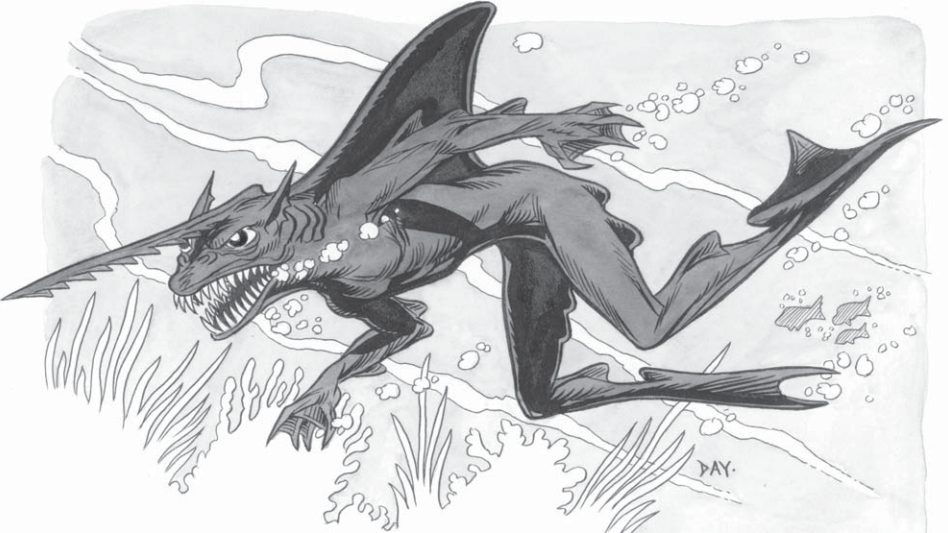
Adaro (CR 2 Medium-size Monstrous Humanoid)
Evil fishmen found in the waters of Oceania. They happen to like the taste of human flesh, but they're also greedy bastards, so they'll often set up protection rackets in island villages to get what they want. If someone doesn't respect them or fights back, like soldiers are probably likely to do if they encounter them, the adaro can fight back with an arsenal pretty damn impressive for a creature of such a low Challenge Rating. Not only do they have sharp claws and a long serrated horn, they are also capable of going into a barbarian rage, teleporting, summon rain and stormy waves, summon sharps, or turning water droplets into poisonous flying fish missiles .
 The adaro may be overpowered for its CR, but it's overpowered in style.
The adaro may be overpowered for its CR, but it's overpowered in style.
Alraune (CR 7 Medium-size Undead)
Alraune is a specific individual, though the fact that her occult origin (impregnating a woman with semen taken from the dirt below a hanged man) is written down means there could theoretically be more than one. She is a temptress figure, said to be a flawlessly beautiful ivory-skinned raven-haired woman, and is definitely a deadly femme fatale. In addition to having spells as per a 6th level Wizard and a negative energy touch, Alraune has defenses in the form of fast healing, damage reduction, and an obscene +8 turn resistance. As if that wasn't enough, she also has a two-part gaze attack. With this gaze attack, she can either influence men and then bestow a curse on them or just screw subtlety and force a save-or-die effect.
American Super Soldier (CR 8 Medium-size Outsider)
Sort of a mix between a guardian angel and Captain America, the American super soldier is a GI who was brutally experimented on by SS occultists but managed to survive and escape, transcending his human nature to become a hero figure who appears to groups of Allied soldiers who are in dire straits and need a helping hand. The super soldier's ability to teleport anywhere in the world instantly, tactical skills, and firearms proficiency mark his role as an NPC entity who comes to help the players out of a jam if the GM feels like the story calls for him.
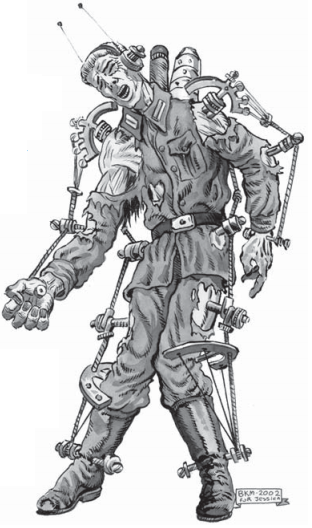
Animated Dead (CR 1 Medium-size Undead)
The animated dead is a freakish mix of clockwork parts melded into flesh and ionized fluids replacing blood, created by Nazi machinists who wanted to prove that they could do the whole zombie thing just as well as the occultists could. While not some amazing monster to write home about as far as power levels go, animated dead do have one trick zombies don't in the form of being able to expel electrical bursts around themselves to shock foes with 2d12 electricity damage, which is surprisingly potent for a monster meant to be sent up against first level characters.
Asphyxiation Zombie (CR 3 Medium-size Undead)
Most of the time, the Weird War II books are surprisingly level-headed and caring about the horrors of war - this entry is not one of those times. No, the asphyxiation zombies are the final result of the final solution, being undead raised by a special occult-juiced form of Zyklon-B used in specific gas chambers in some concentration camps. They can cause fear with their distorted and bloated appearances, their bites induce confusion, slashing or piercing weapons can sometimes cause them to rupture and leak nauseating gasses, and why the hell does this entry exist

Aswang (CR 6 Medium-size Shapeshifter)
Ah yes, Dungeons and Dragons 3.0, back before 3.5 decided that Shapechanger was better as a subtype rather than its own full type. Aswang are vampiric creatures from the Phillipines that have a human shape, but can also take the form of a dog, horse, or pig. They sneak out at night to paralyze victims and the drain their blood, and can also spread a curse that causes anyone that fails a rather high Fortitude save to become an aswang come the next sunset. Thankfully, Filipino shamans can cure an aswang, transforming them back into a human with the proper rituals just as long as someone captures the creature alive to deliver it to the shaman.
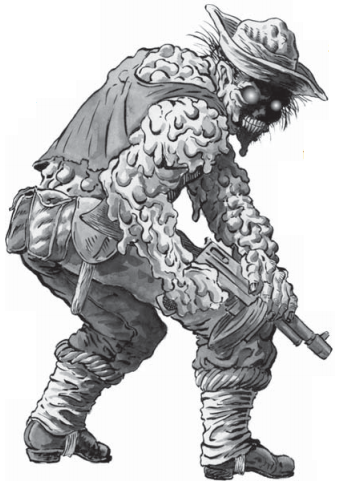
Atomic Marine (CR 4 Medium-size Monstrous Humanoid)
Let it not be said that the Axis were the only people who did stupid shit in the Weird War II universe. These pleasant fellows are the creation of one Jack Garnets, an Illinois scientist who decided that asking the military to stuff soldiers into a room full of experimental radioactive super-compound was a good idea. It went about as well as you'd expect. The resulting "atomic marines" are merciless, emotionless killers who don't differentiate between Ally and Axis - if it's in a uniform, it's a target. They roam the jungles of southeast Asia, having escaped the GI handlers that were foolish enough to think they could control them, and kill any soldiers from either side that they find. In addition to having radiation-resistant firearms, atomic marines exude a field of damaging radiation or use their twisted hands as brutal claws. Another benefit of their nature is that they are both gooey and warm enough that they get damage reduction, as pretty much anything that hits them is going to come away melted.
Axis Apes
Technically three of the one hundred creatures in the book, but I've collected them into this one header because they're all tied together. For some reason, the Nazis and Japanese alike decided "hey, you know what would be great? Gorilla soldiers" and started work on several wacky experiments. The results are the three axis apes. The first type is the ape in uniform (CR 2 Large Animal), which is basically a hulking gorilla that has had its intelligence augmented enough to be used as menial labor of a cheap guard. The second type, the human with an ape brain (CR Medium-size Humanoid), is a POW that has been "devolved" into a clawed, fanged, ill-tempered dumb brute who is used for the same things the ape in uniform is. The last of the three is the ape with a human brain (CR 3 Large Humanoid), a cripplingly wounded Axis soldier who had their brain put into a gorilla's body so that they could continue to fight in an even stronger form in spite of their original body's disabling injuries.
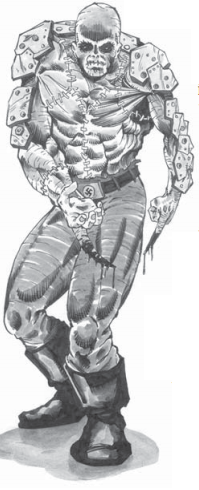
Axis Stitch (CR 9 Large Construct)
What's worse than a flesh golem? A flesh golem with metal plates sewn onto it and spikes for hands. While they aren't healed by electricity like normal flesh golems - they're animated by Nazi blood magic instead of zappity zaps - they do have magic immunity, super-strength, and the other goods of a flesh golem combined with rending spike attacks and enhanced defensive capabilities thanks to their fancy steel suits.
Battle Spirit (CR 13 Huge Undead)
An uber-poltergeist created from numerous soldiers' ghosts, battle spirits wait underground until battles break around around them, at which point they burst out and lay waste like invisible tornadoes of doom. They have +4 turn resistance, energy drain, and can telekinetically throw around pretty much anything they feel like.
Black Annis (CR 6 Medium-size Monstrous Humanoid)
Black Annis is an evil hag that lives in England's Dane Hills. She's an evil creature that desires nothing more than power and the flesh of humans and livestock to feed her relentless hunger, and the fact that she keeps popping up after being slain or banished seems to indicate that there's either more than one "black annis" hag or that she's immortal. The text seems to suggest that the latter is definitely true (though the former may be as well), and that Black Annis was a pagan goddess before being magically bound and downsized to her haggish state, which is why Nazi blood mages have been trying to sneak into England and recharge her back to her former wicked glory. As she is, however, Black Annis isn't exactly a pushover. Her claws are vicious tools of rending, her wailing cry can strike fear into those who hear it, her spit is a corrosive acid, and she can either turn into a black cat or summon a cat swarm. What good a cat swarm would actually do is up to debate, but she can do it nonetheless.
Black Peter (CR 8 Medium-size Outsider)
A demon who was once in the business of guiding souls into the arms of Hell before he ended up being beaten and enslaved by good old St. Nick. It turns out that centuries of servitude to a jolly bearded saint does a toll on a demon's sanity, though, and now Black Peter has found his way out of bondage and is ready to cause some serious suffering. His powers are spell-like abilities related to deceit and illusions, has a pretty big bonus to most social skills, and has a guilt trip gaze attack that causes a -1 penalty to attack rolls for 1d3 rounds if it succeeds. If his social skills weren't enough, however, he can also just straight up choke you with the magical chains that surround him or send his two kludde hounds to attack you while he disappears into a nearby shadow.
Black Wood (CR ? Huge Fey)
Whoops, looks like someone forgot the Challenge Rating line on this monster. The black wood is an evil faerie creature that has been forced into the form of a twisted ambulatory tree. While they can exude a bitterly cold fog, their primary method of combat is pretty straightforward: use their sticky sap to trap a foe close, impale them with their sharp branch-arms, and then suck out their blood.
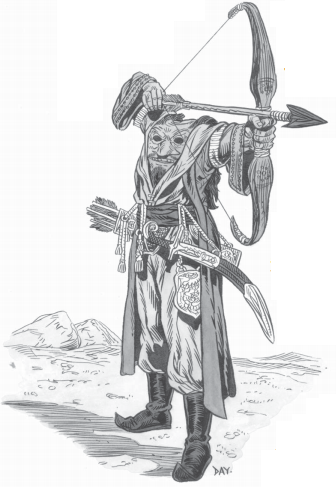
Blemmye (CR 1 Medium-size Humanoid)
These strange humanoids are found in Sudan and southern Egypt and can be easily identified by the fact that they have a face in their chest. They are cautious but skilled warriors, typically living a nomadic existence riding from cave to cave on camel-back and raiding human settlements under the cover of darkness to attain supplies. Germans have been pretending to be British colonials and forcibly manufacturing a conflict between the blemmyes and the British and Arab denizens of the region. In addition to the big boon that is being able to take character classes, blemmyes are crack shots that double the effective range of the effects of the ever popular Point Blank Shot feat.
Carrion Vulture (CR 1 Small Undead)
Rotting undead vultures that can induce fear and have a paralytic bite. They do what vultures do best and don't really have any motive beyond the desire to feed, though they are incidental players in the war because of the fact that blood mages have figured out that carrion vultures can predict where a battle will take place and watch them accordingly. They also hate reptiles for some reason and will attack them on sight.
Catafalte (CR 5 Large Monstrous Humanoid)
Catafaltes are that old wive's tale about cats stealing your breath taken to the extreme conclusion. They are lion-sized anthropomorphic cats that believe stealing human essence can bring forth their evolutionary potential and make them more human. In truth, the breath-stealing is a Constitution damage attack that grants the catafalte a permanent +1 to their Contsitution score every time it successfully kills someone by taking their breath away.
Chill (CR 1 Medium-size Aberration)
These strange icy wisp-blobs float around at night and suck heat from people. Interestingly enough, unlike many monsters that have A Constitution damaging attack, the chill's heat drain isn't meant to kill as it floats away satisfied with its meal as soon as the target falls asleep from having 0 Constitution. Fear not, however, as the book specifically suggests that the War Master use the chill against people who need to stay awake such as sentries and guards.

Chinese Dragon to Hades Corps
Original SA post
Part 2: Chinese Dragon to Hades Corps
Chinese Dragon (CR 9 Large Dragon)
A Lawful Good dragon that claws and bites at evil people and dazes non-evil people if forced to fight them. Eh.
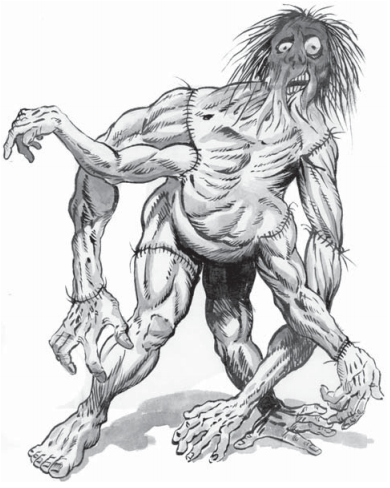
Composite (CR 5 Medium-size Construct)
Tied directly to a later monster called the Doctor X (we'll get to those in a little), composites are heaps of flesh and limbs sewn together haphazardly and animated. They have a primitive intellect compared to mindless things like golems, but only to the extent that they can comprehend simplistic plans and desire to help their Doctor Xs in things such as guard duty, kidnappings, or just plain-out warfare. As far as anything beyond basic combat goes, though, it's sort of a crapshoot of the dice. The composite's extra limbs may or may not work depending on a dice roll, and sometimes a dice roll will have their redundant organs bring them back to life after being apparently destroyed.
Curse of Frankenstein (CR 8 Large Monstrous Humanoid)
The curses of Frankenstein, or Frankenstein troopers, are the results of Nazis taking Victor von Frankenstein's original scientific papers and expanding on his work. After repeated tests, they have created brute warriors who have no fear but can induce fear in others with their aura, are still vulnerable to fire but no longer fear it, have fast healing and damage reduction, and are equipped with Wolverine-style hand blades and a machine gun.
Dead Man's Helmet (CR - Tiny Undead)
The helmet of a dead man. Specifically, it's the helmet of a soldier who died a very traumatic death and their spirit is bound to it. If anyone puts the helmet on - which is more likely than you'd think, as it has a compulsion aura - they'll get spammed with random incoherent flashes of the dead soldier's life and gain PTSD for 2d6 hours, at which point the spirit departs. It's basically meant to be a hazard more than an active monster.
Deserter (CR 1 Medium-size Undead)
The deserter is the undead spirit of a soldier who deserted their unit and died on the run. It can't really do much besides shoot its rifle, which it will at pretty much any uniformed officer it sees as it panics.
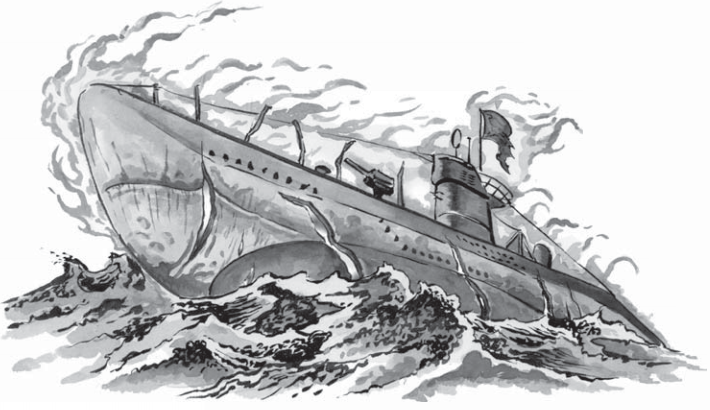
Der Einzelgaenger (CR 5 Gargantuan Undead)
Ghost U-Boat! As you might guess from the low Challenge Rating, however, it's not a big brutish war machine like a haunted vehicle. It's incorporeal and has no weaponry. Don't let that fool you, though - Der Einzelgaenger has a dark trick up its sleeve. With decent ranks in Bluff and Intimidate, it can spook and mislead an Allied ship crew into falling right into an ambush by very corporeal and very armed active U-Boat patrols.
Djinn (CR 7 Large Elemental)
Yadda yadda smokeless fire made etc. etc. blah blah. Weird War II interprets the description of genies as meaning they are invisible fire elementals, whose actions can vary widely depending on the personal outlook of the specific djinn in question. They have the power to spread disease or possess an animal and are healed by fire, but suffer photophobia that forces them to hide or possess an animal during the day. If push comes to shove, they can also just simply whack people with their giant invisible scimitars, which certainly works just as well as sneaking around.
Doctor X (CR 5 Medium-size Monstrous Humanoid)
As if regular Nazi mad scientists weren't enough, the creatures known as Doctor Xs were formerly reputable doctors before being brainwashed and forced to endure and dish out physical and psychological torture until either they committed suicide, died, or went insane. Those that su rvive all call themselves Doctor X, all have scars and deformities from self-experimentation, and prey upon either wounded soldiers or the downtrodden such as prostitutes or mental institute patients. They torture and experiment on people and use the bodies of those they kill to create the composites we saw a few entries up. As far as their own combat capabilities go, they have a scalpel (stats the same as your standard 1d4 damage D&D knife) that deals triple damage as long as the Doctor X is engaging one-on-one or has the superior overall numbers compared to his foes.
Electrical Man (CR 2 Medium-size Construct)
Straight-up Nazi robots. They look vaguely like diving suits made out of metal and rubber joints, have flashlights and human brains inside of their domes, and are proficiency with submachine guns. They are considered to be experimental and rarely seen outside of their creation facility in Haigerloch, Germany.
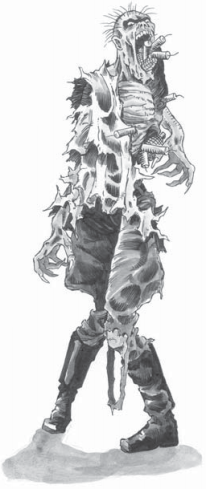
Explosive Zombie (CR 1 Medium-size Undead)
It's a zombie filled with explosives. Doesn't get much more straightforward than that.
Fever Spider (CR 1 Small Animal)
Particularly intelligent for an invertebrate and capable of keeping pace with a wolf, these blood red Indonesian jungle-dwellers are one of those things that seem tailor-made to mess with arachnophobes at your game table. To make things even worse, they are stated to be extremely territorial and will follow someone they bite until they die. Their name comes from the fact that their bite spreads a bacterial infection that induces a high fever and Constitution damage.
Finn Haunt (CR 2 Medium-size Undead)
These are our first example of a creature that actively opposes and targets the Allies alone but isn't of Nazi make. The Finn haunts are the ghosts of Frisian warriors who remember when the Anglo-Saxons killed their people, and are pissed as hell that Anglo-Saxon descendants are descending upon Germany once again. Their spell-like abilities are all tied into what they do to British people when they find them: ghost sound[./i] to lure people into buildings, hold portal to close the doors of the building, and [i]produce flame to set the building on fire. When they are in fire, Finn haunts can fully manifest and use a Wisdom-draining attack to further complicate matters for the poor Brit.
Flagellant (CR 4 Medium-size Undead)
There...there are not enough
 s in the world to describe this entry. Intelligent undead made by blood mages from Nazi soldiers who suffered major stomach wounds, flagellants act like the most twisted moral support ever, using their entrails as bullwhips to attack the enemy and to whip themselves or Nazi soldiers under their command into a barbarian rage. This exists in this book. I swear to you I am not using hyperbole on this monster.
s in the world to describe this entry. Intelligent undead made by blood mages from Nazi soldiers who suffered major stomach wounds, flagellants act like the most twisted moral support ever, using their entrails as bullwhips to attack the enemy and to whip themselves or Nazi soldiers under their command into a barbarian rage. This exists in this book. I swear to you I am not using hyperbole on this monster.
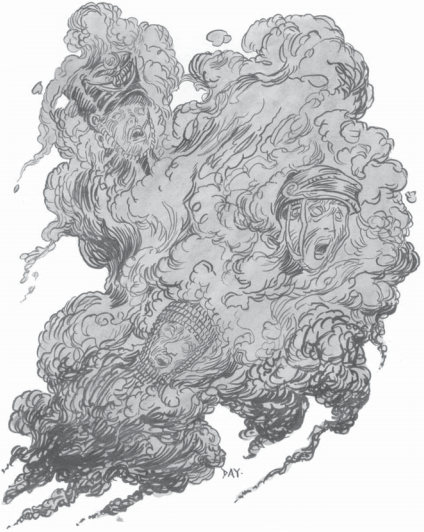
Fog of War (CR 4 Large Aberration)
The fog of war is a rather twisted monster, a gaseous maliciousness that rises in times of war for the sole purpose of instigating friendly fire. To achieve this end, it has a litany of spell-like abilities related to illusions and the ability to attempt to force itself into someone who fully enters its foggy body and thus dominate their actions. As for fighting back? Well, it's fog, so most attacks aren't going to do much and explosives or non-AoE spells in particular only do half their normal damage on top of the prodigious damage reduction being made of mist grants. On the other hand, strong winds and heavy rains can damage if if you can whip them up, and electrical and water-based attacks deal double damage to them.
Gangrene (CR 1 Medium-size Undead)
A plague zombie by any other name.
Gehrinesser Gruppe (CR 7 Medium-size Shapeshifter)
One of the more insidous experimental entities of the Nazis, the gehrinsser gruppe are faceless folk who can take on someone's form, skills, and feats by consuming their brain. Depending on how they conserve their brain matter, this ruse can go on for months, which makes them a very dangerous unseen foe. The only flaw of their mimicry is that they have to consciously make an effort to avoid using the opposite hand of the victim they are impersonating. This means that a proper Bluff check can blow the game away as the gehrinesser gruppe literally shows its hand.
Ghillie (CR 5 Medium-size Aberration)
These freakish parasites have a vaguely humanoid shape made out of brown and green mulch and leaves. It can take over a host by engulfing them and beating them at a Will save, effectively using them as both a defense and as a food source for their blood draining attack. As long as ghillie is attached, the host gets the boon of its abilities and camouflage, but is also liable to take damage that is actually intended for the ghillie. The ghillie also grants the Sniper prestige class's crippling shot ability, as it likes to leave its potential new victims alive.
Ghost of the Red Baron (CR 10 Huge Undead)
The ghostly figure of Manfred von Richthofen and his soul-bound plane are one of the most dangerous tricks up the Nazi air command's sleeve. He can manifest anywhere in Germany (but not outside of it) and is effectively immortal, simply reappearing later if he is shot down. The only way to truly end Richtofen's second reign of terror is to find the bone talismans that the Nazi blood mages used to summon his spirit, take them all to his grave, and then consecrate it in a funeral ritual. It's more or less a whole adventure of its own, which is probably for the best when dealing with such a historical figure.
Grendel (CR 11 Huge Giant)
For some unknown reason, this infamous giant of legend has managed to survive his apparent death in the old sagas. He still has a lost arm from his fight with Beowulf, though, and he has an obsession with ripping off people's right arms in vengeance. Then again, he tends to rip things off in general, as he goes from town to town with no real goal other than slaughter and sustenance. He's certainly a beast in combat as well - even if you discount his ability to go into a rage and make his already prodigious strength even higher, his amazingly rough hide forces a save-or-break on any melee weapon every time you hit him. The only saving grace is that he is sluggish and weaker during the day, which means that you could defeat him easier if you somehow manage to find his sleeping spot.
Hades Corps (CR +1 or +2 Template)
The Hades Corps are the ultimate SS soldiers, ones who literally survived going to Hell and back. Their origin is in an experimental attempt to harness infernal energy for the Nazi war machine that instead sucked the research facility into Hell, where only the toughest SS soldiers managed to fight their way back to our world. A soldier with this template becomes an Outsider with the Fire subtype. Their touch burns, touching them burn, and on top of that they can burn with various fire-related spell-like abilities. And if you manage to kill one, they explode into a fireball for even more fire. Examples are provided of putting the Hades Corps template on a Grunt 4 and an Officer 7.
---------------------------------------------------------------
Next time: French cannibals, Japanese ghost samurai, Arabic temptresses, and more.
HMS Sapphire to Orang-Bati
Original SA post
Part 3: HMS Sapphire to Orang-Bati
HMS Sapphire (CR 12 Colossal Undead)
Nicknamed "The Deadnaught", the HMS Sapphire was a World War I era dreadnaught that was secretly built in South Africa and mysteriously sank in the Atlantic on her maiden voyage. The ship is now a vengeful spirit of the sea whose crew hunt for shipwrecks to scavenge even more souls from in order to fill the entire sea with the sorrow of forgotten tragedy. The undead sailors expand in a dark fog at a 90 foot radius around the Sapphire, clawing at anyone they come in contact with, while the ship itself is effectively immortal unless you can find exactly where it actually wrecked and pull off a proper burial ritual. This means that, as with the ghost of the Red Baron, a big part of this ghostly vehicle's encounter potential is in the adventure around putting it to rest.
Homme-Rat (CR 1 Medium-size Monstrous Humanoid)
Rat people that live in the sewers and catacombs of France. They like to eat people and perform ritual sacrifice, but that's pretty much all that's known about them.
Husk (CR 3 Medium-size Monstrous Humanoid)
The husk could be described as the desert equivalent of the Canadian wendigo. Like the wendigo legend, the husk is formed when a human in dire conditions turns to cannibalism and insanity - in this case, someone in the desert turning to blood-drinking. The result is a warped monster with a leathery hide, long claws, and sharp teeth. It has no supernatural powers to speak of, but its psychosis and strength make it a dangerous foe if it can use its stealth to get the jump on a small group of low-level characters.
Infiltrator (CR 4 Medium-size Shapechanger)
The Japanese shapeshifting spy guys. Unlike the Nazi versions, these ones don't have to eat brains to keep up a disguise, instead using spiritual power. They are also weaker overall and have more of a focus on manipulating team members into dissent as opposed to their Nazi counterparts' long-term subterfuge.
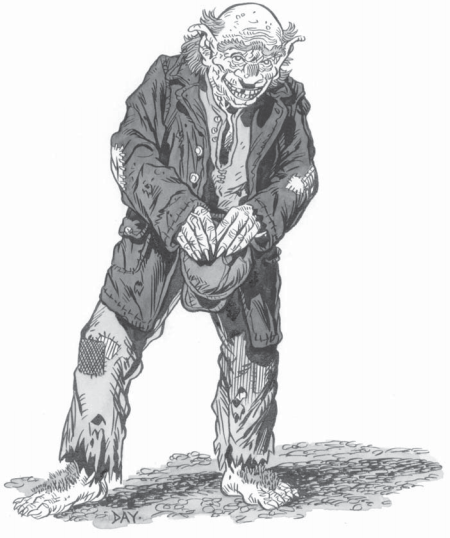
Izgoi (CR 1 Medium-size Fey)
Our next species that is stated to take character classes at long last!
 These are the izgoi, a Russian term referring to exiles or orphans, who are unsurprisingly found in eastern Europe. They live in small villages lead by a ruler known as a hedman and a matriarchal shaman known as the vedomye zheny. They are a hardy fey folk that have damage reduction, regeneration as long as they have their feet in touch with the earth, and spell-like abilities related to stealth and further defensiveness. They also have a +1 bonus to saving throws and attack rolls as long as they are within 12 miles of their home village, but suffer Constitution damage for every week they are away from it. Both the Russians and Germans have tried to sway the izgoi to their sides, but they have pretty much refused both, even sometimes creating small retaliatory militias to fight off Nazi invaders.
These are the izgoi, a Russian term referring to exiles or orphans, who are unsurprisingly found in eastern Europe. They live in small villages lead by a ruler known as a hedman and a matriarchal shaman known as the vedomye zheny. They are a hardy fey folk that have damage reduction, regeneration as long as they have their feet in touch with the earth, and spell-like abilities related to stealth and further defensiveness. They also have a +1 bonus to saving throws and attack rolls as long as they are within 12 miles of their home village, but suffer Constitution damage for every week they are away from it. Both the Russians and Germans have tried to sway the izgoi to their sides, but they have pretty much refused both, even sometimes creating small retaliatory militias to fight off Nazi invaders.
Kamikaze Spirit (CR 3 Medium-size Undead)
The Japanese occultists known as the Kuromaku (who we'll learn more about in the book Land of the Rising Dead) happened to create these guys by accident. The original intent was just to fuel kamikaze pilots with black magic, but it turned out that a side-effect was the creation of a unique type of undead that seeks out even more planes to crash. Its modus operandi is to sneak into a ship, Wisdom drain the pilot into a nightmare-filled sleep, take the reigns of the plane to crash it into an Allied ship, and then head to a new plane to do it all over again.
Keel Wyrm (CR 3 Huge Beast)
Beast, the other creature type besides Shapeshifter that existed in 3.0 but disappeared in 3.5. Our first example of tis type in Weird War II are the keel wyrms, giant versions of the keel worm . While they aren't particularly dangerous, they have a bad habit of living in groups that slow down ships as they build numerous calcified burrows on the underbelly, which means anyone diving to try to fix the issue has to deal with about a dozen or so snapping jaws from freaky 20 foot-long worms.
Khamsin (CR 5 Medium-size Outsider)
Either earth-bound genies or cursed Amazons depending on who you ask, the khamsin have the form of beautiful Arabic women and are fond of seducing religious men away from the tenets of their faith. While they prefer to merely toy with humans, they can certainly hold their own if combat comes up, being capable of spreading disease, forming a dangerous whirlwind, or emanating a heat wave that simultaneously protects them from cold attacks and deals nonlethal damage to those that near it.
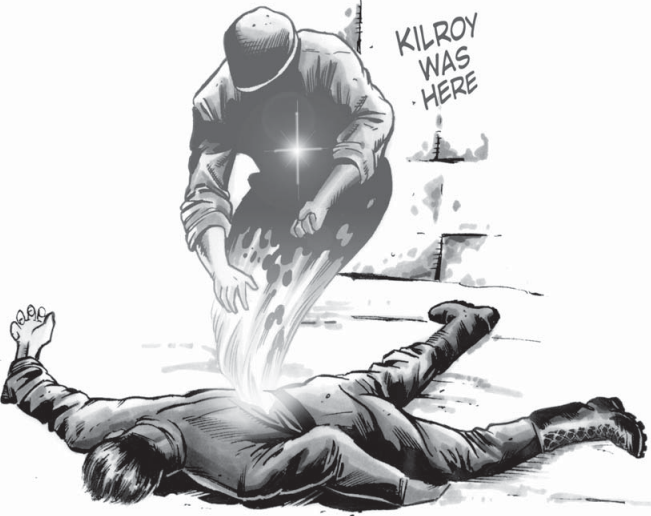
Kill-Roy (CR 10 Medium-size Undead)
"Kilroy was here": a strange slogan etched by American GIs during World War II and later, often merged with the graffiti of a large-nosed ledge-peeker by the name of Chad whose origins were from the British part of the Allies. Or, at least, that's the real world origin. In Weird War II, finding "Kilroy was here" is a much darker message spread by the entity known as the Kill-Roy. This creature was born Roy Sharpes, a private who ended up dying in the Pearl Harbor raid. Fueled with rage, he came back as a spirit who would drive others to their deaths, stealing their essences and eventually becoming a horrific blood red gestalt of all of the Armed Forces that seeks only the death of the Axis through suicide attacks from American soldiers. The Kill-Roy will possess soldiers and force them to fight at their fullest and die in the heat of battle, their spirits being absorbed into its own as the message "Kilroy was here" magically marks itself on a nearby surface. Even more interesting is that Kill-Roy is an enemy who can only be truly effectively fought with words rather than actions - he'll just rejuvenate and reappear eventually if he is attacked and destroyed, meaning that the only way to deal with him is to free a possessed soldier by convincing Kill-Roy the soldier would do more damage to the enemy alive than dead or to finally put him to rest with a well-researched and convincing argument that its path of violence is in vain and that it should disperse its souls into the afterlife.
Kon-Nichiwa Samurai (CR 1 Medium-size Undead)
Better known as "that dick thing your GM uses", these entities are the souls of samurai summoned and bound by the Kuromaku into an armored zombie. The kon-nichiwa samurai is deceptive in its low Challenge Rating. Sure, its hit point total is miniscule, but it also regenerates to full health after 5 minutes of being unconscious. The only way to truly kill them is to perform a coup de grace with their own katana or spear after they have been knocked unconscious, a fact that the players probably don't actually know given that the kon-nichiwa are the personal enslaved bodyguards of select Kuromaku. The plus side of all of this is that they have a hilarious death:
Horrors of Weird War II posted:
When they are released from unholy service, a bright light flashes from the face mask of the armor and beautiful music and the scent of cherry blossoms fills the air.
Lebender Schlamm (CR 14 Large Construct)
You probably wouldn't have guessed that our toughest monster so far would be a mud golem. That's exactly what the lebender schlamm is, though, being a golem created from the bloody mud of trenches. In addition to the magic immunity that all golems enjoy, the lebender schlamm can shapeshift to sprout tentacles for extra attacks or squeeze through tight spaces as an oozing mass, has high damage reduction combined with an immunity to slashing and piercing damage, can regenerate health as long as it is in contact with the ground, can up its speed once per day in combat, and is capable of engulfing and suffocating foes.
Leopard of Rudyaprayag (CR 8 Large Beast)
It's a giant leopard with above-human intelligence, the ability to sense traps, and fast healing. It's used by an evil chaos cult to spread disaster during times of war. And...that's pretty much it. Hell, the book doesn't even tell you where Rudyaprayag is (it's a town in the forested mountains of Northern India).
Living Fountain (CR 3 Large Construct)
Empathic statues found in European towns. They're capable of healing with their waters, but they don't have any attack, movement, or anything else. Really, they are more a magic item of convenience than a monster, and I'm not sure why they are taking up a spot in this bestiary.
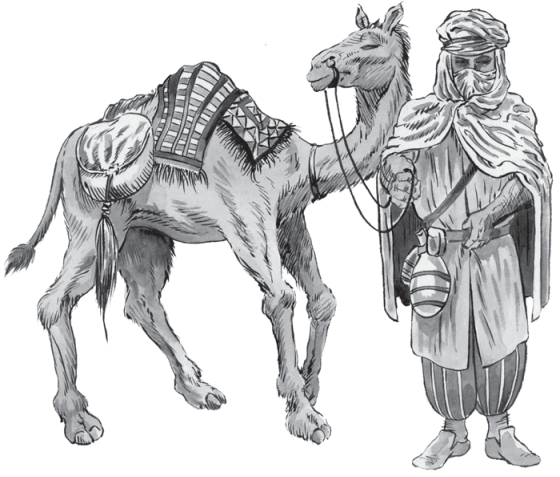
Lost Caravan (CR 5 Medium-size Elemental)
These earth elementals are actually the spirits of a group of Berber salt merchants who were massacred by raiders centuries ago, now under a compulsion to forever wander the wilderness and steal people's body salt like that one monster in Star Trek. They do this by appearing to those who are lost and starving in the desert, offering them food and drink that actually has a sleeping poison in it. If they fall asleep, a magical jar is placed at their feet that drains them of their salts. If they making the saving throw and stay awake, two hours later the members of the Lost Caravan get pissed off and start slashing around with their sabers and jambiya daggers. They are immortal due to the dying curse of the tribesman that swore vengeance, but they can be thwarted by just beating them up until they are temporarily destroyed or managing to hold out until dawn, since they are incapable of manifesting during the daylight hours.
Luna-Tick (CR 1/2 Tiny Vermin)
Black ticks with a crescent moon marking on their back that drive people in a paranoid rage as they drain blood from them. Get it?

Master Chef of France (CR 8 Medium-size Humanoid)
The master chefs are cannibals who are said to have gotten their secret of human flesh-based immortality from the Marquis de Sade. They are effectively broken into camps of those who only eat the flesh of the dead and those who hunger for fresh human meat and go out to murder them, but both are equally ultra-nationalist and hate the Nazis with a passion that drives them to aid the French resistance movement. Combat-wise, master chefs have high-ranking fast healing and immunity to poison on their side.
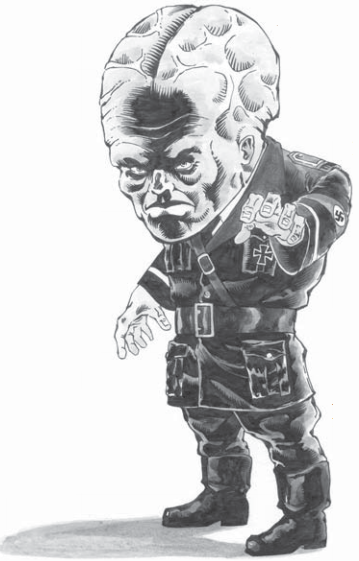
Mind Reaper (CR 4 Small Humanoid)
Mini-me big-brained Nazi experiments whose shtick is that they love mind-raping people. They are constantly capable of detecting thoughts, and can use this to either rip out pieces of a foe's memory, temporarily stun them, or deal Strength and Dexterity damage. They can also take class levels.
Muumuu (CR 3 Large Giant)
Besides having a hilariously amusing name, the Bigfoot-like ogres known as the muumuu are feared in the south Pacific for the fact that they come down from their jungle mountain homes to steal away humans as food. They are stron, clever, and can swiftly move around in the trees to ambush Allied and Axis troops moving through the jungle. They're another creature that can advance by class levels, which is always a plus.
Nuba Oni (CR 4 Large Monstrous Humanoid)
The nuba oni are a tribe of the legendary Japanese oni that have been drafted into military service by the Kuromaku. In addition to being big horned monsters that have a fear-inducing aura, brute strength, and sharp claws, the nuba oni have been trained to use firearms and katanas. They are also heavily resistant to fire, so some have been trained to puncture Allied flamethrower tanks to cause a conflagrating explosion that the nuba oni can easily walk away from compared to the quite possibly dead flamethrower user.
Orang-Bati (CR 1 Medium-size Monstrous Humanoid)
These freakish bat-ape-people fly through the jungles of Indonesia and are feared for the fact that they take humans in the dead of night to sacrifice in blood magic rituals. They also happen to believe that they are the rightful ruling species of the planet, but are thankfully of small enough numbers that they can only carry out their domination fanasies on a local scale. Their two notable powers are the ability to release a mournful wail that can induce chaos and panic and, if they happen to be spellcasters, sacrifice a human child once per day to double their 1st level spells per day. Orang-bati can take character classes.
---------------------------------------------
Next time: Dragons that aren't, rats that swarm, and NPC monsters that aid.
Osterkov Dragon to Schatenmeister
Original SA post
I had planned on getting this post out sooner, but I've been sick as a dog lately.

Part 4: Osterkov Dragon to Schatenmeister
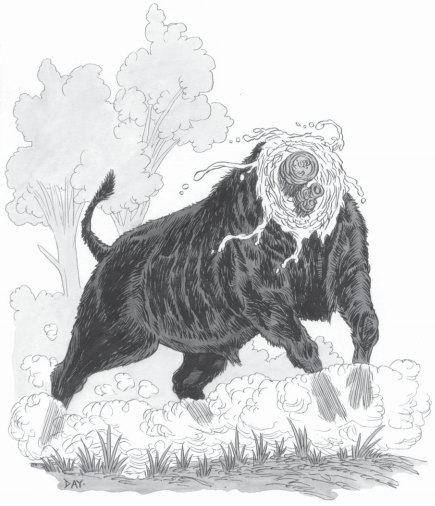
Osterkov Dragon (CR 7 Large Magical Beast)
When is a dragon not a dragon? When it's...
that
thing, I guess. While called a dragon people by the people who tell its tales, the Osterkov dragon is a supernatural ox that has been without a head ever since a German warrior lopped it off in battle 1,500 years before World War II began. It was always an unpleasant beast, but it's been driven mad and woken up by all of the fighting going on near its home on the border of Denmark and Germany, and is all too willing to brutalize anyone that enters its forest. The Osterkov dragon's typical attack strategy is to soften up the earth, send vines to entangle a foe, or erect a wall of brambles and thorns, after which it just violently slams its hooves into the prone character. It has a special 4d12 damage attack it can do to characters it has pinnd, which kills them through violent head explosion at 0 HP rather than sending them into the dying state of negative HP like a normal attack. If that wasn't bad enough, it also happens to be immune to any damage other than grappling or a direct strike to its neck stump, both of which are dangerous given that its blood is extremely poisonous - 2d4 Constitution primary, and then 4d4 Constitution secondary, a level of poison I don't think any standard D&D creature has.
Oyasuminasai Ninja (CR 4 Medium-size Outsider)
Like the kamikaze spirits and kon-nichiwa samurai seen in the last post, these guys are tied to the Kuromaku. Unlike them, however, they are obviously not undead. They are from another dimension but have sworn fealty to the Kuromaku in order to gain access to our world. They are basically just ninja that can teleport through shadows within their line of sight and are weakened by sunlight. Woo.
Pacific Trap Plant (CR 2 Medium-size Plant)
Giant ferns that have tentacles they use to grapple people and then suck their fluids out.
Pain (CR 12 Large Outsider)
A being of pure emotion made manifest, a pain is born when mass tragedy illicits such an emotional reaction that it leaves a psychic scar on the area. It's also stupidly dangerous. Not only do its attacks gain 5 feet of range every time it successfully attacks or its foes either fail an attack or fail a Strength check against it, but it also has a save or die attack on its grapple. Its
grapple.
And someone who dies to that save-or-die grapple? They get sucked in and automatically destroyed, so there's no way to resurrect them either. The final insult to injury is that you can't actually damage a pain with conventionl weapons or magic. You have to instead sit and meditate, spamming Will saves to damage it until it eventually collapses into itself, at which point there's a big Will save you have to make or permanently suffer 1d4+1 Intelligence drain and develop a mental illness. What a
fun
monster.

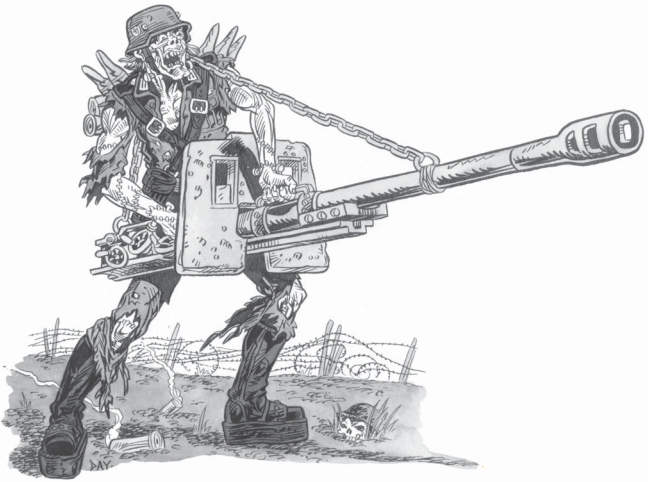
PaK Mule (CR 3 Medium-size Undead)
PaK mules are the heavy weapons guys of the Nazis' zombie hordes, being super-strong brutes that haul around a special antitank gun known as the PaK HEAT due to the fact that it is so strong it would kill a living being if it was held and fired. Of course, they do kind of have a big flaw in and of themselves - namely, any time you deal damage to a PaK mule, it has to make a Will save or drop its gun and just punch everyone around be they friend or foe.
Panzerschrek (CR ? Medium-size Undead)
Whoops, an entry where the Challenge Rating was left out of the stat block. Panzerschreks are the ghosts of tank crews that have been summoned back to the mortal coil by Nazi blood mages, namely by taking an antitank weapon such as a rocket launcher and then coating it in magical runes. The panzerschrek is bound to this weapon and cannot get too far from it or it will despawn for a while. It can also be despawned by water or strong winds. In its favor, it does of course have an antitank weapon to blow up tanks with like it's supposed to, and it can also engulf people in smoke and start choking them if it has to face a human foe. A panzerschrek will resurrect unless its antitank weapon is destroyed or dispelled.
Papuan Dragon (CR 4 Huge Animal)
A dragon that isn't but sort of is. By which I mean it's not a dragon-dragon or the Dragon type, but it's a giant Komodo dragon, so it's sort of a dragon but at the same time...oh, forget it. It's a big-ass 25 foot long lizard that lives in Papua New Guinea and does giant lizard things - namely eating people.
Paul Revere (CR 4 Medium-size Outsider)
Like the American super-soldier - remember him? - Paul Revere (who may or may not be
the
Paul Revere) is a spirit of good that helps out Allies who are in distress. He appears to warn of extremely unpleasant combat situations and how to beat them, with troops that follow his orders getting a free
bless
spell cast on them. He then disappears mysteriously for reasons nobody remembers.
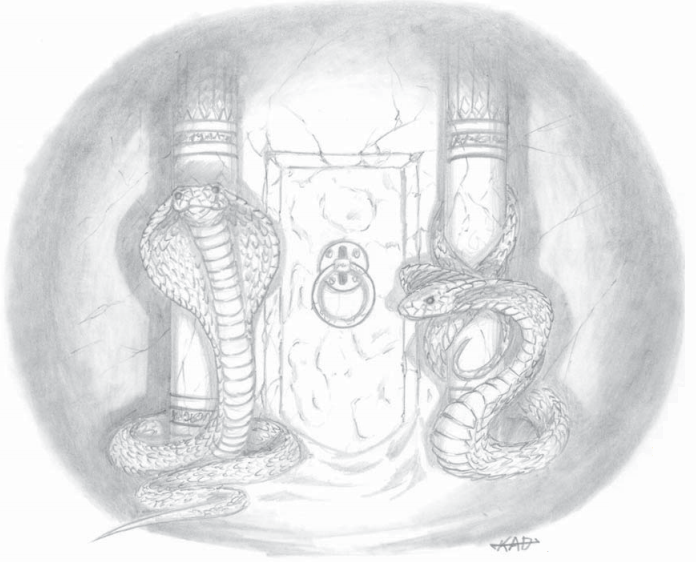
Pharaoh Cobra (CR 2 Medium-size Magical Beast)
These supernatural serpents are said to have been created by ancient Egyptian sorcerers, which makes sense given that they are always found guarding tombs and temples in Egypt and Libya. They are actually more intelligent than the average human and are capable of either just doing straight-up venomous cobra shenanigans or using hypnosis against their foes. Their Lawful Neutral nature means they protect their tombs rather than pick sides in the war, but the Nazis and Italians have been capturing some of them for devious experiments.
Phoenix Legionnaire (CR 10 Medium-size Humanoid)
While they happen to look like skeletons in Roman legionnaire's armor, these entities are actually members of a mystery cult known as the Legion of the Phoenix that have been caught in a state of half-life ever since they pledged to protect Rome from evil when the flames of war engulfed it. That time has come, and now they rise to fight the Axis when the sounds of battle raise them from their ageless sleep beneath the ground. Phoenix legionnaires have fast healing but are otherwise rather nondescript, even having flat 10s for all of their physical ability scores. There's a reason for that, though - every time the legionnaire hurts an enemy in combat, he gets to roll a 1d6, with any roll other than a 1 granting him a point in either Strength, Constitution, or Dexterity to a maximum of 18. If he can get all three scores to at least 14 before the battle is over, he is fully reborn as a human but gets to retain his fast healing. If he runs out of foes before he can get the prerequisite ability scores? Death awaits.
Quisling (CR 4 Small Fey)
In addition to looking like miniature versions of Marvel's Kingpin, the quislings are best known for being assholes that love to sew seeds of deceit and betrayal. To achieve that end, they are naturally invisible even when attacking and have several minor illusion-related powers. If they happen to get stuck in an iron circle, though, they are both visible and powerless to do anything but use whatever human-made weapons (typically pistols) they happen to have.
Rat Pack (CR 2 Medium-size Magical Beast)
Technically a bunch of regular-sized rats that act as a single big rat in a cohesive state that even swarms can't reach, rat packs are clever and aggressive due to the arcane energies they have gained from consuming corpses on a bloodied battlefield. That's about all that can be said about them, though, as their only strategy is to bite things.
Resurrected (CR 1 Medium-size Outsider)
The Nazis decided to siphon the spirits of famous generals into living humans. For some reason, however, they decided to use total chumps and leadership bonuses to troop morale are about all these creatures are good for.
Rubble Kitten (CR 0 Tiny Magical Beast)
More of a force than an entity, the rubble kitten will sometimes do acts of GM fiat to heroes that can find one. You have to have Charisma of 16 or higher and be good and kind-hearted to have one appear, and then you have to keep it save or you will get a spate of bad luck (-1 to your bennies for 1d6 game sessions). Stealing one also gives you the same bad luck. The entry is kind of stupid either way.
Russian Riser (CR 1 Medium-size Undead)
These guys are the corpses of Russian patriots who rise up from the grave to attack those that are hostile to the motherland. They have a claw attack, can burrow to assault someone from below, they can soften up the ground, and...that's it, really. Their low Challenge Rating and lack of anything uber spectacular makes it hard to justify them as being better than just having Russian zombies appear or something.
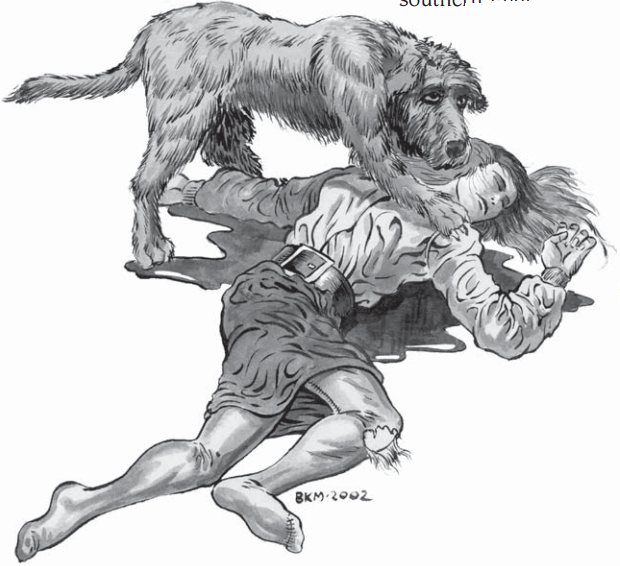
Salty Dog (CR 3 Medium-size Fey)
Part of the grand old tradition of creepy-ass European fair folk, salty dogs are beasts that resemble big old Irish wolfhounds and tend to mooch off of sailors that take them in as ship dogs. Then they get hungry, and their darker side creeps out. A hungry salty dog shapeshifts into the form of a man and goes to seduce a woman, taking her down to the seaside and then drowning and eating her. It then goes back to its wolfhound form and swims back to its "master's" boat to wait until it needs to feed again.
Sand Devil (CR 2 Medium-size Beast)
Freaky desert predators that vaguely resemble the shriekers from Tremors 2. They burrow under the sand and wait until they find weak and weary prey, at which point they burst out and attack. They have a rainforest variant called jungle devils that are arboreal instead.
Scaevolan (CR 1 Medium-size Humanoid)
The Italian attempt at creating brutes, Scaevolans are still human rather than orc-monsters, have their left hands ritually burned off which makes them less effective at combat, and cannot take class levels like normal humans can. Their only real benefit is that they have a +4 bonus to saves against Intimidate checks and a +1 morale bonus to saves and attack rolls. They are literally one of the most useless entities you could possibly make on the Weird War II battlefront. I'm not sure whether they are meant to be making fun of the Italian fascists compared to the Nazis or if the writers genuinely thought this entry was a good idea, and somehow I almost hope it's the former.

Scaratrooper (Medium-size Monstrous Humanoid - CR 2 for regular, CR 5 for Sergeant)
Speaking of Nazi experimentation, these guys are Nazi bat-people made by experiments on paratroopers. They're strong, swift, can use both human-made weapons and their new claws, have fast healing, and can fly, and are used both to attack ground troops and to sabotage planes mid-flight.
Schatenmeister (CR 4 Medium-size Outsider)
These creatures are people made out of shadow that come from another dimension that may or may not be the same one the shadow ninjas come from. They have a deal with the Nazis to cross over to our world and act as assassins and spies in exchange, but Hitler is paranoid about them and only allows a few to come across at a time. They have a craving for human essence and have a Constitution draining attack to achieve that, but also happen to suffer Wisdom damage as they siphon Constitution from humans because of how pleasurable they find it.
--------------------------------------
Next time: We finish off Horrors of Weird War II with wolf-boobs, kamikaze spiders, porcupine people, and the vote for what Weird War II book will be done after this one.
Shkura Devoshka to Zombie Master
Original SA post
Part 5: Shkura Devoshka to Zombie Master
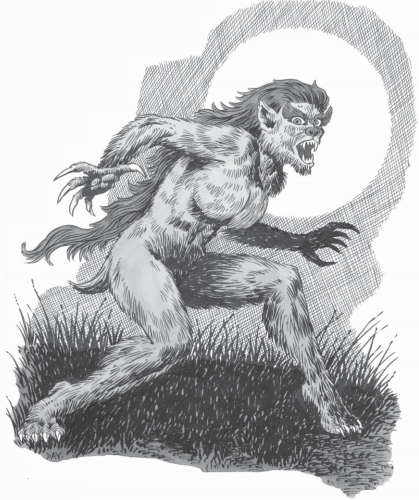
Shkura Devoshka (CR 1 Medium-size Monstrous Humanoid)
Our first species since the orang-bati that can actually take character classes by the rules as written. The shkura devoshka are Neutral Evil wolf-women who may or may not be the feral degenerate descendents of the Amazons. They are pack hunters that have a higher bonus to flanking bonuses than normal humans and have a bite attack that can also deal Dexterity damage through tendon-ripping selective strikes. They will sometimes steal and rape human men, after which they use them for ritual sacrifices. Charming.
Skin Thief (CR 2 Medium-size Humanoid)
Apparently not content with having brain-eating shapeshifters, the Nazis decided that they'd also make infiltrators that literally wear other people's skins. That's pretty much the extent of what the skin thief does.
Soulless (Template)
In a tangled web woven through the Nazi ranks, the Soulless template reflects the ultimate no-win situation. The gist of it is that SS officers sell their souls to demons, Nazi blood mages afraid of their status in the organization then bargain with the demons to eat the souls rather than just buy them and eventually take on the SS officer's body to be able to walk the earth. The template ups class hit dice by one size, adds a +4 natural armor bonus to AC, gives a bite attack, and grants 3/day burning hands . It's not actually made clear whether or not the template reflects the SS officers given power or the demons in their meatsuits, though.
Spider-Bomb (CR 2 Medium-size Vermin)
Speaking of tangled webs... These monsters are the creation of one Tara Von Laven, who decided that it wasn't just enough to use mad science to grow spiders. No, she decided that after growing spiders to giant size, she'd then strap bombs onto them. They're also literally controlled by a joystick, because why not at this point.
Stealthy Stalker (CR 6 Medium-size Humanoid)
Basically the Invisible Man. They are Nazi experiments who went psychotic and decided to head out and just kill people. To this end, they are naturally invisible, have +2d6 sneak attack, and also have uncanny dodge. Stealthy stalkers can technically take character classes, but it states that they can only take levels in Grunt.
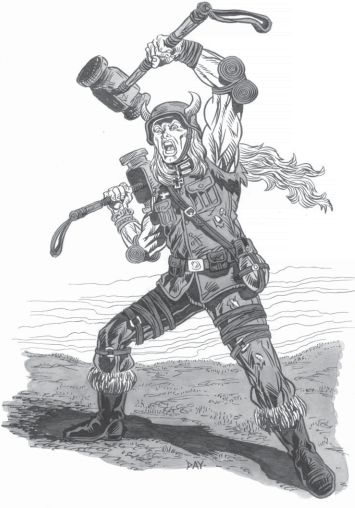
Strosstrupen (CR 3 Medium-size Humanoid)
Nazi supermen. They are resistant to heat and cold, super-strong, and wield hammers made of the magical material vril that they can either bash things with, throw as a missile attack, or use to call down lightning or create minor earthquakes. They can also take class levels, which means that they are actually pretty useful, unlike a certain other Nazi experimental human I can think of *cough*Resurrector*cough*.
Taniec Tytan Pracy (CR 9 Large Outsider)
Taniec tytan pracy, or dance demons, are summoned by Polish occultists to defend them from the Nazis. In addition to being able to masquerade as a human, the dance demons can perform dances that can cause confusion, deal nonlethal damage, or bring forth the ever popular save-or-die touch attack.
Terracotta Warrior (CR 2 Medium-size Construct)
Unlike the real world terracotta warriors, these ones were made by emperors other than Shi Huang Di and were imbued with the occult energies of human sacrifices. The Japanese raiding Chinese tombs during the war have woken up these warriors, and they are now hellbent to take back the treasures of the tombs they guarded. They wield crossbows, swords, and spears and are immune to magic, but otherwise are sort of just generic low-level constructs.
Tikbalang (CR 4 Medium-size Fey)
Tikbalangs are horse-headed trickster spirits from Filipino mythology. In the incarnation Weird War II presents, they've been made incorporeal for some reason, have selective invisibility, and can use what the game calls "Spell tricks":
Horrors of Weird War II posted:
The range of possible pranks is nearly limitless. The effects only ever do subdual damage and never last more then a day. War Masters should consider spell tricks an unlimited amount of 1st level spells, with the restriction that they have to be funny

Torture Master (CR 3 Medium-size Humanoid)
A heinous middle-aged German man, the Torture Master has occult powers that allow him to heighten someone's sense of pain and heal them up so that he can torture them repeatedly without having them die. It doesn't state that he is actually allied with the Nazis, simply that have loves doing torture and getting secrets, so he may or may not actually have any ties to Hitler and his crew. The Torture Master advances by character class, which means he is one of the few cases of a unique entity that you can customize.
Trench Foot (CR 2 Small Vermin)
Trench foot is a Nazi-juiced mold that eats through the body. Seeing as this has no actual ability scores, movement, or stats to speak of other than a spore "attack", this really should be classified as a hazard. You only have an initial saving throw against the mold - if you fail that, it progresses until you either die or amputate the infected limb.
Uber Child (CR 2 Medium-size Fey)
The uber children are fast-grown Aryan fairy clones that climb up walls, use any weapon, and...that's pretty much it. They can't even gain class levels.
Uberhund (CR 2 Medium-size Beast) and Uberwolf (CR 3 Large Beast)
Large, clever German shepherds and large, clever wolves, respectively. They're so bland I'm rather curious as to why they weren't in the core book or some sourcebook with a non-monster focus.
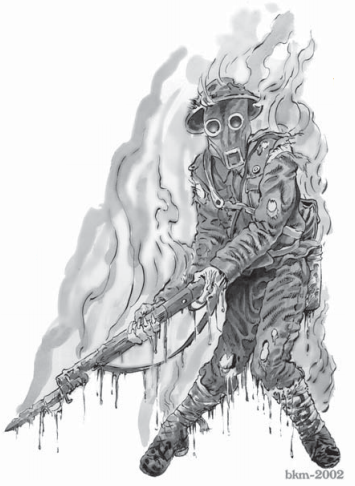
Upturned (CR 5 Medium-size Undead)
The shambling upturned are the undead remnants of World War I soldiers that have clawed their way up to fight everyone in World War II. They can catch enemies flat-footed by pretending to be just another part of a mass grave and also exude mustard gas from their bodies. Other than that, though, they're pretty standard zombie types.
Vandal (Humanoid with CR equal to class level - example Vandal is a Grunt 1/Barbarian 3)
The Vandals are Neanderthal-like warriors created through Nazi experimentation. Since Hitler doesn't trust them (big surprise) due to their loyalty to their officers over him, he tends to send Vandals into the most dangerous missions possible. Vandals advance by class level but must have at least one level in Barbarian, and their ability modifiers are +2 Strength, -2 Wisdom, and -2 Charisma. They are pretty much the only non-human species that are specifically called out as being potentially used by player characters, as there is a small section on the potential of having a player be captured and experimented on as part of the Vandal project before escaping back to their unit.
War Geist (CR ? Medium-size Undead)
Whoops, here's another entry that had the Challenge Rating left off. If you couldn't guess from their name, war geists are ghosts of war who live to bring out fear that they can feed on. They gain one hit point every time someone falls for the hallucinations of the terrors of war that the geists create, and they can also induce fatigue through continued use of their hallucinatory powers.
Wehrmacht Needler (CR 5 Medium-size Humanoid)
Yet another entity that can take class levels...odd that we're starting to actually get a flow of those so late in the title. Wehrmacht needlers are crazy German soldiers who have decided to coat themselves in warding runes before plunging spikes and needles into every part of their body, making them a porcupine-like walking defensive emplacement. Their spines are damaging in close combat, and on top of that they are immune to non-magical subdual/nonlethal damage and have damage reduction. Ever helpful, there is a suggestion from the text that they should be fought in tight corridors and potentially have their spikes laced with poison.
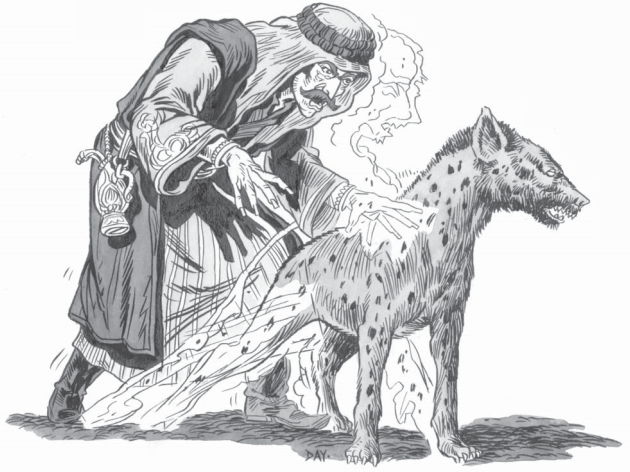
Yena (CR 4 Medium-size Shapeshifter)
The yena is an occultist who can take the form of a hyena. They're found scattered throughout Africa and the Middle East, preferring to live lives either as hermits or as manipulative powers behind the throne, and at least some of them have joined up with the Nazis or local fascist groups. Yenas are natural spellcasters that can innately cast as a 3rd level Sorcerer, and in hyena form their bone-crushing jaws can allow them to deal Strength damage on top of HP damage. Yena can take class levels, typically either Sorcerer to augment their innate spellcasting or some form of charismatic and coercive class.
Also, I'm kind of baffled at that name. There are real world legends of people who become hyenas or hyenas that have magical powers, like the bouda and the kaftar, so why not use one of those instead of hyena without the H?
Yofune Nushi (CR 7 Huge Magical Beast)
These giant one-eyed eel monsters are pretty much the only supernatural creature used by the Imperial Japanese Navy rather than kept strictly by the Kuromaku. Their skin secretes an acidic slime and their huge size means that they are quite physically dangerous, and on top of that three or more yofune nushi within a mile of each other causes a storm to rage around them.
Zombie Master (5th level Human Sorcerer)
These guys are simply, as stated above, humans with 5 levels of Sorcerer that happen to have learned two unique abilities. One is the ability to create a paralytic powder that can be blown at enemies, while the other is the art of the living dead. When raised, these unique zombies are immune to turning and regenerate health. The only way to kill a zombie master's living dead creations is by dismembering the body and putting each part to rest in a different grave or filling the corpse's mouth with salt.
-----------------------------------------------
And with that, we are finished with Horrors of Weird War II. Feel free to vote on which Weird War II sourcebook you want to see next. Your options are...
Dead From Above: Airplane rules.
Africa Korpse: Italians, engineers, Mighty Whitey the prestige class, and trying to juggle Africa-Korps-as-Lawful-Neutral with Nazi zombies.
Hell Freezes Over: Russians, shamans, and
 .
.
Land of the Rising Dead: Sailors, Aussies, Japanese, and demon-worshipping jungle savages.
Chapter 1's Prescient Naming
Original SA postPththya-lyi posted:
Hey fuck you good luck kittens are awesome, and are much less ridiculous than Axis Apes and zombies and whatnot.

It also seems that we have a winner, as
 Hell Freezes Over
Hell Freezes Over
 has swept the voting board.
has swept the voting board.

Part 1: Chapter 1's Prescient Naming
Introduction to Chapter 1, skills, and feats
Our introduction to the Russians in Weird War II is a brief statement about how Russians used shitty weapons and inferior tactics and only won battles because of sheer numbers, followed by the introduction of SOPA. No, not that SOPA, this is a book from 2003. These guys are the Soviet Office of Paranormal Activity, the Russian equivalent of the OSI. SOPA is ddifferent from their western counterparts in several facets - they are not tied to the Sons of Solomon since they betrayed them during Stalin's Great Purge, they only accept people who actually killed a Nazi paranormal entity rather than just people who have seen them, they hoard magical items a lot more frequently, and their atheistic bent means there are fewer Chaplains. Once World War II ends and the Cold War begins, the changing tide will lead to an occult war between the OSI and SOPA.
Second up are new skills and feats. The skills are Ammo and Explosive Manufacturing (you can make bombs, Molotov cocktails, bullets, or artillery shells), Knowledge-Politics (it's a Knowledge variant), Skiing (a very specific fusion of Jump and Tumble), and Winter Survival (should probably just be new uses of Survival). The initial feats are mostly pretty lackluster bonuses to either melee or firearms combat, but there are two that are noteworthy - Party Member gives you a bonus to Diplomacy checks and promotions as long as you are interacting with the Communist Party, while Tank Immobilization lets you use flamethrowers, Molotov cocktails, or antitank guns to specifically target a tank's suspension and more easily deal critical damage to it.
We also get our introduction to weird feats. While they didn't appear in the core rulebook for some reason, they appear in every sourcebook other than Horrors of Weird War II. Weird feats are, as their name implies, weird - some sort of supernatural stimulus has given your character a freaky power. There are four specific ones presented for Hell Freezes Over: Below Zero Resistance gives you cold immunity but makes you have to do Fortitude saves or take nonlethal damage in temperatures of 40 degrees Fahrenheit or higher, Bullet Proof makes you immune to non-critical bullet shots from anything smaller than a 20mm bullet, Propaganda Prophet lets you cast mass suggestion on crowds after long speeches but makes you a target for the Communist Party if you aren't saying what Stalin wants you to say, and Vodka Healing lets you heal 1d6 points of damage for every 12 ounces of vodka you drink.
Character Classes
Before we get into full-on new classes, we get some archetypes for classes from Weird War II. Unlike the class archetypes you'd expect frm 3.5, however, Weird War II's archetypes are more often than not just glorified equipment packages.
-
Dog Handler:
This archetype is for the Grunt, Medic, and Scout classes. You get a dog as an animal companion, but are otherwise pretty much a standard member of your class.
-
NKVD:
An archetype for Grunt or Officer that reflect a character that is part of Stalin's secret police. The only actual benefits are some free equipment and a few extra class skills, though.

- Partisan: The Partisan is an archetype specifically for the Resistance Fighter. It ups the Resistance Fighter's hit die size from d6 to d8 and their "safehouse" can actually include an entire village or a lonely chunk of forest or swamp, but their forged papers are less effective.
As for actual new classes, there are three.
-
Cavalryman:
Average rather than full Base Attack Bonus progression, good Reflex save progression, and a class feature that lets him use his horse as a living shield are the only things that really differentiate the bonus feat-spamming Cavalryman from the bonus feat-spamming Grunt, Officer, or Fighter.
-
Commissar:
While his Fortitude and Reflex save progressions are very poor, the Commissar has average BAB progression and great Will save progression. He also gains two notable class features in addition to bonus feats: one is the ability to
 without repercussions, while the other allows him to make Knowledge (Politics) checks to impose a mind control ability on his subordinates.
without repercussions, while the other allows him to make Knowledge (Politics) checks to impose a mind control ability on his subordinates.
- Shaman: Shamans are dedicated natural spellcasters who have a guardian spirit that they must emulate in their clothing and revere in their magic. With strong Fortitude and Will save progressions, they tend to be made of tougher stuff than most spellcasters, but they also have a lot of restrictions in that they have to wear specific items for specific spells - a shaman must have a drum if casting a spell with a verbal or somatic component, must wear gloves to cast touch spells, etc. Guardian spirits grant domains similar to gods, with the example Siberian guardian spirits being Gray Wolf (Animal domain), Reindeer (Good domain), Brown Bear (Healing domain), Arctic Tern (Soul Travel domain), and Yeti (Weather domain). As long as a shaman has a staff, he can also transform into the image of his guardian spirit once per day. Shamans also gain access to helper spirits (20 presented overall for Siberian shamans) that grant them a specific spell-like ability, two spell-like abilities, or a spell-like ability and a skill bonus/feat once per day. Some examples include Earthworm granting soften earth and stone , Muskrat granting endure elements and reduce , Husky granting animal friendship and resist elements , and Weasel granting confusion .
Prestige classes are a lot simpler. The OSI Adept, OSI Operative, and OSI Chaplain are renamed SOPA Adept, SOPA Operative, and SOPA Clergy, and there's a new prestige class called the Guardsman. With d12 hit dice an full Base Attack Bonus progression, the Guardsman is meant to be the party tank. On the downside, they only have some bonus feats every other level and no unique class features to make them stand out as anything but "the tank".
-------------------------------------------------
Next time: chapter 2's equipment and chapter 3's
 history.
history.
Ordinance & Equipment
Original SA post
Part 2:
Chapter 2: Ordinance and Equipment
New gear related to the Russians and the Russian front starts out our small but required pair of chapters in the review.
-
Russian Vehicles:
Mostly tanks with a smattering of other artillery and one support vehicle. Statistics are provided for the BA-64B, IS-2, ISU-122, ISU-152, KV-1, KV-1S, OT-34, SU-100, SU-122, SU-152, T-34 Model 1943, T-34/85, and a generic leased American truck.
-
Russian Weapons:
The Nagant 1895 and Tokarev TT33/34 are presented for pistols, the Model 1930G and Tokarev SVT-40 for rifles, the PPSh 1941 and PPS 1942 for submachine guns, the Maxim gun, DP 1928, DShK 1938, and SG 43 Gpryunov for machine guns, and the RPG-43 and F-1 frag grenade for explosives. None of them have particularly exceptional stats compared to Allied examples of similar weapons.
-
Russian Planes:
The Lavochkin La-5FN, MiG 3, Yak-3, Yak-9, Ilyushin Il-2 Shturmovik, Ilyushin Il-4, Petlyakov Pe-2, and Tupolev Tu-2 are provided as aircraft supplementing the standard Allied ones found in Dead From Above.
- German Vehicles: The Axis decided to push into this chapter a little bit as well, with a few vehicles that heavily featured on the eastern front. New stats are provided for the PzKpfw III, PzKpfw IIIL, and Sturmpanzer IV "Grizzly Bear".
Chapter 3: The Great Patriotic War

Time for a history lesson! This chapter starts with an explanation of the non-aggression pact between the Soviets and the Axis, as well as how it cracked with the Winter War of Russia and Finland. There's also a bit of smugness about Stalin supposedly not quite expecting the German assault on Russia:
Weird War II: Hell Freezes Over posted:
Hitler even made his obsession for living space known 16 years before Directive no. 21 in his book Mein Kampf(My Struggle), '…to guarantee to the German nation the soil and territory to which it is entitled on this earth, we are bound to think first of Russia and her border states.' Stalin obviously wasn’t a big reader.
 I mean, it's not like we Americans ever underestimated Hitler."
I mean, it's not like we Americans ever underestimated Hitler."
After that gloating, the discussion further heads on to talk about Hitler's hubris and refusal to listen to Goebbels' statements about how simultaneously attacking Russia and the UK was a bad idea, the delay of the Russian conflict thanks to Mussolini getting the Axis into a fight with Greece and Yugoslavia, the beginning of the German assault and Operation Barbarossa, Leningrad, the winter offensive, Stalingrad, and most of the other general points of the eastern European front up to the Red Army rolling into the Reichstag at the end of the war. What we really care about is the alt-history stuff, though. One of the most repeated points is the topic of vampires. In Weird War II, Hitler's biggest goal is to transform himself into a vampire, and there's no shortage of them in eastern Europe. One of the big plot points for SOPA in the siege of Berlin is that rather than committing suicide like in our world, Hitler gets his vampire formula and bolts from Berlin, leading to a climactic final fight between Russians and vampire Hitler at the Swiss outpost that leads into the Hollow Earth. The Hollow Earth itself may or may not be a cleanup mission in and of itself, as it's posited that more than a few Nazis carved out their own small empires within the savage realm of dinosaurs and Neanderthals found beneath the Alps.
------------------------------------------------
Next time: New Nazi NPCs, the Finns,
 and other eastern European vampire lords, hags, and yetis.
and other eastern European vampire lords, hags, and yetis.
Chapter 4's Fang Fascination
Original SA post
Part 3: Chapter 4's Fang Fascination
It's time for the most notable chapter of Hell Freezes Over, entitled Eastern Opposition.
Additional German Opposition
While the core rulebook's German NPCs were heavily based with generic SS soldiers, Hell Freezes Over gives much more specific groups. Details are given on the Eisatzgruppen (the monstrous regiments that doled out most of the ethnic cleansings of the Nazi ranks), the Berlin guards of the Volkssturm, the infamous Hitler Youth, and non-Nazi but pro-Axis nationalist groups such as those from Finland, Hungary, Romania, and Slovakia. The specific ones statted out are the Eisatzgruppen soldier (Grunt 6), Eisatzgruppen (Officer 9), Hitler Youth (Grunt 1), Volkssturm (no class levels), Finnish soldier (Grunt 2), Finnish officer (Officer 5), minor Axis soldier (Grunt 1), and minor Axis officer (Officer 1).
Vampires
In real life, the Nazis were willing to give Hungary the ownership of Transylvania as punishment for Romania's Allied allegiances during the first World War. In Weird War II, however, the purpose is a more sinister attempt to keep Hungary and Romania at each others' throats while the Nazis sneak in and hunt for vampires for Hitler's vampire serum. They also have their eyes on scattered vampire villages in frosty Siberia and the artifacts created and hidden by various ancient and powerful vampires. One of the vampires you might encounter is, of course,
 himself. Vlad Dracula is tied to several supernatural creatures at once rather than just the vampire, as it is said that he sought an audience with the Devil himself while astride a dragon, and that some blood mages attempt to do the same.
himself. Vlad Dracula is tied to several supernatural creatures at once rather than just the vampire, as it is said that he sought an audience with the Devil himself while astride a dragon, and that some blood mages attempt to do the same.
New Monsters for the Russian Front
Hell Freezes Over gives us a total of 11 new monsters.
-
Baba Yaga (CR 4 Medium-size Monstrous Humanoid):
The monstrous hag witch that lives in a chicken-legged hut, famous through many Russian folk tales. She also happens to hate Germany for past and current feuds with her witch kin and can be convinced to aid the war effort. She has frightful presence, a paralyzing gaze attack, spell-like abilities of a wide variety from fire and water magic to illusions and debilitating powers, a special wand charged up with
hold person
, a mortar and pestle that can fly, and her infamous hut. She also advances by class levels that you as the GM choose, which is why she is so surprisingly low level.
-
Bannik (CR 3 Medium-size Outsider):
Banniks are spirits of the bath house from Russian mythology, spending most of their time just sort of chilling in their house of choice and sometimes playing pranks on foreign bathers. They can be pissed off fairly easily, however, as lying, boasting, swearing, loud singing, excessive talking, and sex in the bath house all draw a bannik's ire and leads to hot coals being thrown around. As far as game stats go, the bannik has a fear aura and a load of illusion and mind-affecting spell-like abilities and can gain class levels.
-
Corrosive Rot (CR 7 Huge Plant):
A vaguely humanoid heap of rotting vegetation, the corrosive rot haunts fetid swamps and bogs such as the Pripyat Marshes. They are willing to eat pretty much anything that gets within range of their flailing vine-tentacles - animals, people, vehicles, doesn't matter. It has the equipment to do so as well, as its tentacles are just a way of leading prey into a twisted maw that deals 1d6 bite damage plus a whopping 4d8 acid damage.
-
Exploding Corpse (CR 4 Medium-size Undead:
Zombie + flammable gasses and liquids. Hitting them enough leads to a big 12d10 damage boom.
-
Grave Bane (CR 6 Huge Undead):
Another creature in the fine Weird War II tradition of "monsters that are actually more or less hazards". The grave bane's only ability is to bestow a curse on someone that causes them to seek out and kill the highest-ranking officer that took place in the execution of the grave bane. Given that grave banes are only made from Jews, Roma, Slavs, and others murdered by Nazi eugenics brigades, however, I can't see how it's that much of a curse for any good-aligned character.
-
Gutter Rank (CR 1 Tiny Aberration):
These freaky kidney-looking creatures slither around in sewers and other dark, wet places in search of small prey such as rodents. If they're startled by a larger creature such as a human, however, they'll latch on and start injecting foul gasses into the nearest organ. If it happens to attach near the heart or brain, it's a save-or-die effect. Woo.
-
Hate Feeders - Poltergeist (CR 4 Small Outsider), Possessor (CR 4 Medium-size Outsider), and Manifestation (10 Huge Outsider):
The hate feeders are three forms of dark human spirit made manifest. Poltergeists are mostly known for telekinetically throwing objects around and other spell-like abilities based around property damage and harassment, possessors are souls from Hell that require a human body to possess in order to remain on Earth, and the manifestation is the result of the two combining into a writhing column of pure hatred. The manifestation has exactly 666 hit points
 , is immune to turning, and cannot be killed unless it is struck by a
dispel evil
spell. Its offensive powers are just as dangerous,
cloud kill
,
black tentacles
,
reverse gravity
, and a fear aura being just icing on the amorphous pseudopod-slamming cake.
, is immune to turning, and cannot be killed unless it is struck by a
dispel evil
spell. Its offensive powers are just as dangerous,
cloud kill
,
black tentacles
,
reverse gravity
, and a fear aura being just icing on the amorphous pseudopod-slamming cake.
-
Ice Ooze (CR 7 Huge Ooze):
It's an ooze that is camouflaged in ice and snow and has cold tentacles. Hooray, I guess.
- Yeti (CR 6 Large Magical Beast: Known by other local names such as the chuchuuna and almas, the yeti is a large tribe-dwelling primate found in highlands from the Caucasus to Siberia and down to the Himalayas Mongolia, and China. In addition to being brutes in melee, they are capable of letting out a paralysis-inducing howl and using stealth-related spell-like abilities.
----------------------------------------------------
With our trip through the frozen hell being over, the Weird War II books left are Afrika Korpse, Dead From Above, and Land of the Rising Dead. Which one comes next is up to you.
Chapter 1's Appropriation Station
Original SA post
Part 1: Chapter 1's Appropriation Station
Welcome to Afrika Korpse, the Weird War II sourcebook that focuses on the North African conflict of the early war. This means we're going to be getting a lot of heat, sand, Italians, and Rommel worship. Like any journey, though, it starts with a step, and that step is of course the character options chapter.
Starting Packages
A list of regiments found in the Allied side of the North African conflict. As they are basically meant to be a quick list of items, skills, and feats for a GM to give a 1st level NPC from that regiment rather than any new game rules, we'll just skip past it.
New Skills and Feats
To start off actual new content, we begin with a few new skills. Entrench lets you roll to create cover, Observation and Assessment is a rather stupid skill that is basically a Spot check and Knowledge check rolled into one new skill, and Wireless Telegraphy lets you correctly use telegraphs and is thus probably the only of the three that is actually warranted as a new skill rather than new use of an old skill.
For new feats, there's mostly a lot of sand acclimation going on. Arid Acclimatization ups the lowest temperature considered to be extreme heat for you, Desert Defenses grants skill bonuses to Demolition, Hide, and Entrench in the desert, Desert Fox is the same but for Listen, Move Silently, and Spot, Sahara Lore is the same thing for Knowledge and Gather Information, and Find Water helps you more easily find water. There are a few interesting unrelated feats, however. The Elan feat grants a bonus to Will saves and melee charges while also lowering the penalties suffered when using pistols, shotguns, or sub-machne guns in melee combat, the Honest Face grants you a bonus to Diplomacy and Gather Information as long as you don't lie or deceive, and then the Gone Native feat....wait, the what?
"Weird War II: Afrika Korpse posted:
You exhibit an affinity for local customs, get along easily with natives, and know enough about their ways to pass yourself off as one of them, especially among those unfamiliar with their culture (although blonde hair and blue eyes might impose a penalty).
The feat would almost be serviceable for its primary use, which is a collection of skill bonuses when interaction with a culture you are innately familiar with. You could have called it Cultural Studies or something. But no, it also grants a bonus to duping non-native people who don't have the Gone Native feat because you're just that convincing as another ethnicity .
At least the weird feats this time don't have anything quite as awkward as that. Mine Sense lets you detect mines nearby but forces you to make a Will save or become paranoid and cower when you find them, Radio Head lets you hear radio transmissions telepathically but dulls your actual senses of hearing and sight, Rune Tattoo grants you a +2 bonus to any ability score other than Charisma but causes you to suffer a -2 Charisma penalty due to an unsettling aura about you, Solar Healing lets you heal faster in sunlight but deprives you of even standard natural healing in darkness, and Trembling Hands makes your hands shiver to warn you of a potentially dangerous action but obviously causes penalties to skills related to working with your hands during that time.
New Prestige Classes
-
Fitter:
While this prestige class has piss poor Base Attack Bonus progression, it makes up for it with good Will save progression and abilities that focus on letting your character customize mechanical equipment, repair vehicles more efficiently, and even repair otherwise unrepairable critical failures to keep a vehicle going longer than it should be able to. You have to be Australian, British, or a New Zealander to take the prestige class, though, so apparently no other nations in the world have vehicle techs quite as good.
-
LRDG Officer:
Rather than being a variant of the Officer base class, the Long Range Desert Group (LRDG) Officer is a prestige class that doesn't really grant much more benefits than staying straight-up 20 levels of Officer. It grants bonus feats like an Officer, has average BAB progression and save progression for all three save types, has some extra bonus languages the regular Officer can't learn, and gets a +3 bonus to Listen and Spot checks against aircraft.
-
Minefield Engineer:
These combat engies focus on demolitions and night operations, getting darkvision, the Elan feat's benefits for free, and the ability to call in specialized demolition vehicles known as flail tanks. They're otherwise pretty average.
-
Native Guide:
This prestige class focuses on maxing out the benefits of the Gone Native feat. Joy. It keeps increasing the bonuses the Gone Native feat provides, grants the Lay of the Land feat for free, gives two ranks of sneak attack, and increases the character's diplomatic influence with the native people.
- Signaler: You get access to a radio and high frequency direction finding equipment as your class features. Don't you feel special?
-------------------------------
Next time, we go through the remaining three chapters of the book. Afrika Korpse is surprisingly short.
Of Rotting and Rommel
Original SA post
Part 2: Of Rotting and Rommel
Chapter 2: Ordinance and Equipment
Most of the new equipment added this time is related to Italy, though there's also some more German material.
-
Weapons:
The new firearms are the Modello 89B and Beretta M1934 pistols, the Carcano Modello 91/24 rifle, the Breda M38 machine gun, and the SRC Modello 35 grenade. None of them have particularly notable assets compared to standard weapons.
-
Generic Equipment:
Want stats for flimsy cans, jerry cans, magnetic compasses, san channels or sand mats to aid vehicles in a rut, or a sun compass? Well, they're here. There are also notes on clockwork detonators and pencil fuses for explosive.
-
Vehicles:
I hope you like tanks, because there's a lot of them. Germany gets stats for the Panzer IB, Panzer IIC, Panzer IIIG, and the SDKfz 9 halftrack, Italy gets stats for the Command M41 recon vehicle. M13 tank, and Semovente M40 tank, and the Brits get the A13 and A15 Cruiser tanks, a fitter's truck, a Long Range Desert Group modified jeep, a LRDG light truck, the Marmon-Herrington armored car, a signal van, the Matilda III tank, the Valentine II tank, and the Vickers light tank.
- Aircraft: Germans get the Fieseler Fi 156 Storch recon plane, Italy gets the Caproni Ca309 Ghibli bomber, Fiat BR20 Cicogna transport, Macchi MC200 Saetta fighter, and SM79 Savoia Sparviero recon bomber, and the Brits get the Bristol Blenheim Mk IV bomber, Bristol Bombay Mk I bomber/transport, and Westland Lysander recon plane.
Chapter 3: Operational Overview
The prerequisite GMing chapter starts with a timeline of the African conflict from Italy's declaration of war to Rommel's departure from northern Africa, but quickly segues into actual game rules. These start with talk about the harsh terrain of northern Africa. The muddy traps of salt marshes, rugged passes of desert mountains, and minefield-laden scrub are only made worse by blistering heat in the day and bitter cold at night or the threat of sandstorms. Indeed, if your character happens to be an arcane spellcaster, there is a 5th level spell called summon khamsin that lets you whip up a hot sandstorm to throw at your foes. It does lead to some awkward misunderstanding if you recall that the bestiary happened to have a monster called the khamsin as well, though.
The third section of the GMing chapter is focused on places to go and people to see. After noting the basics on potential African bases of operation during World War II such as Cairo, Casablanca, Tobruk, Tripoli, and Benghazi - the last of which has an adventure hook for a special forces group to invade it and take out forces controlling it, which may be awkward to modern audiences - there's a laundry list of big names in northern Africa on both the Allied and Axis sides. The one who gets the most
 is, of course, Rommel himself. Not only does he get two pages of exposition compared to a few paragraphs for men such as Patton, Rommel is the only named historical figure of the lot that gets a stat block. He's a Lawful Neutral 17th level Officer, if you were curious.
is, of course, Rommel himself. Not only does he get two pages of exposition compared to a few paragraphs for men such as Patton, Rommel is the only named historical figure of the lot that gets a stat block. He's a Lawful Neutral 17th level Officer, if you were curious.
Last are a collection of new NPCs. While the majority of these are your standard Grunt 1 or Officer 4 with specifically desert-themed skills, feats, and equipment, some NPCs of note are the completely fictional Special Salvage Group Mages. These guys are the classic Lawful Evil Nazi blood mages that love to torture people, mutate them, and raise a bunch of zombies. Rommel is stated to have taught them the ways of desert warfare and allowed them to infiltrate standard German infantry units, but somehow he's still totally Lawful Neutral guys because his units didn't do all the evil zombie stuff. They just facilitated it, that's totally different, right?

Chapter 4: Bestiary
-
Aajej (CR 8 Huge Elemental):
These charming fellows are giant bloodstained whirlwinds created by the life force of mass deaths seeping into the sand and connecting with elemental wind. They're basically a whirlwind hazard that happens to be capable of intelligent planning as far as stats go.
-
Cipher Imp (CR 2 Tiny Outsider):[b/] These minions of Hell are summoned by Nazi blood mages to spy on Allied communications. They are capable of understanding any language that has ever been spoken by the human tongue, which means they are more or less a direct plot device for the villains discovering a Signaler character's relayed plans. Their only method of combat is their claws, which have a poison that deals Dexterity and Wisdom damage. There is a 3rd level Adept spell supplied to summon one as well.
-
Colossus (CR 4 Large Construct):
10-15 feet in height doesn't really scream "colossus" to me, but whatever. These guys are guardian golems that look like statues of pharaohs and gods of old Egypt. The text says that Muslims have wiped out most of them that aren't in extremely remote or forbidden places because they are graven images. Other than having the ability to produce a fear effect when they suddenly spring to life, they are pretty standard punchy-slammy-damage-reductiony stone golems.
-
Corpse Mine (CR 2 Medium-size Undead):
Do you need another zombie suicide bomber besides the ones that were in Horrors of Weird War II and Hell Freeze Over? Well, here's yet another one.
-
Flugzeuggeist (CR 4 Large Aberration):
These vaguely human-shaped hulks made out of burning plane parts are flammable and spit molten shrapnel at foes. The text says they are demons, but they are statted as the Aberration type.

-
Ghul (CR 3 Medium-size Undead):
It's a D&D ghoul plus a fear aura. Yay.
-
Ienpu (CR 2 Medium-size Magical Beast:
These wild-eyed magical jackals are stated to be the servants of Anubis, ferrying souls to the afterlife. Of course, they happen to be Neutral Evil and will accept killing someone with their jagged fanged bites as "ferrying into the afterlife", so...yeah.
-
Judgement Beast (CR 12 Huge Outsider):
These Lawful Evil spirits resemble the soul-munching hippocrocolion of legend, Ammut. They can be summoned with a 9th level spell and a copy of the Book of the Dead, but only in lands that were once part of the Egyptian empire, and pretty much just bite and trample things with their huge bodies.
-
Sand-Rot Mummy (CR 2 Medium-size Undead):
Unlike standard D&D mummies, these guys have no Intelligence and are basically zombies that happen to be dried up like jerky. They even have the whole "partial actions only" aspect.
-
Supply Rat (CR 1/3 Small Animal):
A dire rat by any other name would be just as diseased.
-
Twisted Hulk (CR 7 Huge Construct):
Flaming tank mechs animated by vengeful ghosts. They have an obscene damage reduction 50, meaning that any attack other than their weakness will pretty much be shrugged off. Fortunately for the heroes, their weakness happens to be good old H2O.
- Wireless Hound (CR 4 Large Magical Beast): In spite of the name, these "hounds" are actually giant crested porcupines with ogre-level Intelligence. Their spines vibrate painfully in the presence of radio waves, which drives them into a rage and causes them to track down and violently attack the radio emanating the waves. Those that are jabbed with their quills also feel the pain of the radio sensitivity and suffer a -1 penalty per embedded quill to all rolls within 75 feet of a radio. Both the Axis and Allies use wireless hounds as living weapons against enemy radio outposts.
----------------------------------
Next time: The bland and the blue as we cover the entirety of Dead From Above in one sweeping post.